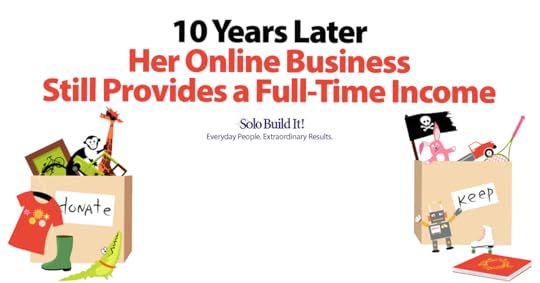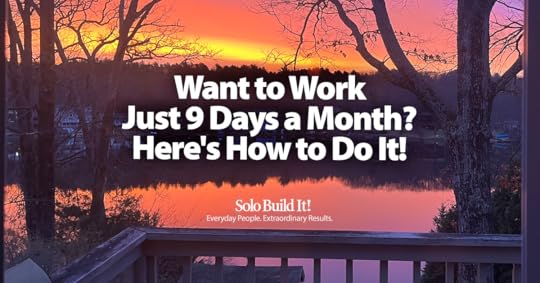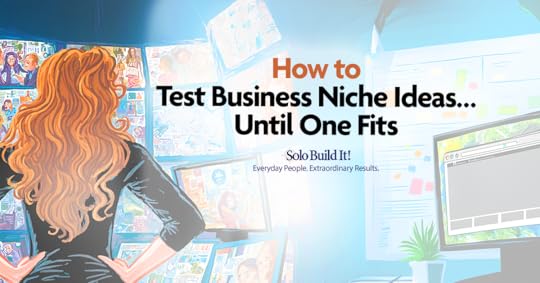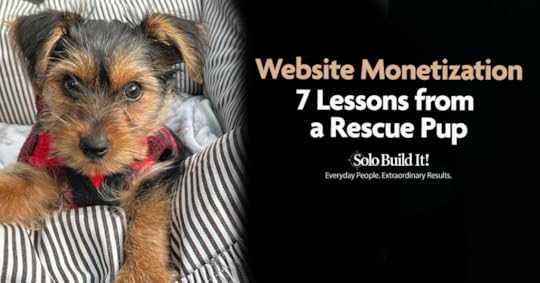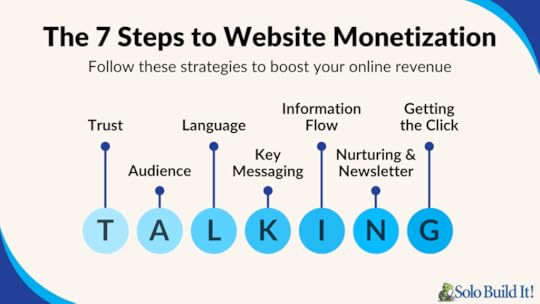Val Silver's Blog
November 6, 2025
Conquer the Blank Page: A 4-Step Blueprint (Part #4 of 4)
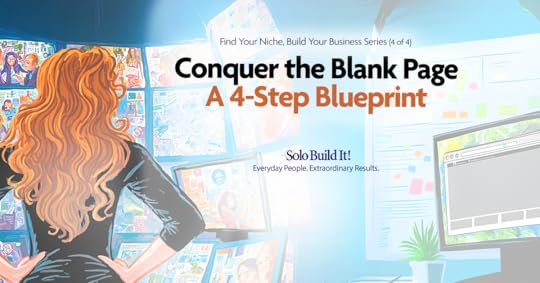
Writing your first article can feel intimidating. Whether you’re starting a blog, niche site, or online business, staring at a blinking cursor can stop even the most excited beginner in their tracks.
In this final part of our series on choosing your niche, we’ll show you a clear, beginner-friendly method for going from a blank page to a finished article, without writer’s block or overwhelm.
You’ll follow along with our friend Gardener Grace, whose first article topic is:
A Beginner’s Guide to Your First Balcony Herb Garden
Step 1: Craft a Clear, Keyword-Rich Headline (The Promise)Your headline is the promise of your article. It tells readers (and search engines) what they’ll get.
Grace’s headline is simple and effective:
A Beginner’s Guide to Your First Balcony Herb Garden
Why it works:
It clearly identifies the audience (beginners)It includes her main keyword phrase (“balcony herb garden”)It promises value — a beginner’s guideOther strong headline variations could be:
How to Start a Thriving Balcony Herb Garden in 5 Simple StepsBeginner’s Herb Gardening: Your Step-by-Step Balcony GuideBalcony Herb Garden 101: The Easy Way to Start Growing Fresh HerbsChoose a headline that uses keywords your audience is searching for, while also sparking curiosity.
Step 2: Write a Hook That Connects Emotionally (The Connection)Your hook is your opening paragraph. Its job is to make the reader feel seen, by tapping into their thoughts and fears.
Grace’s hook might look like this:
Imagine stepping out to your balcony herb garden to snip fresh basil for your pasta. It’s a lovely thought, but if you’re like most beginners, the fear of killing your first plant before it even grows is very real. Don’t worry, we’re going to start from scratch.
This works because:
It paints a clear, emotional picture (the dream)It acknowledges the fear (killing plants)It promises a solution (starting from scratch)Tip: Hooks don’t have to be long. A short, vivid scene or empathetic statement like any of the above is enough to keep readers moving.
Step 3: Build the Body With 3–5 Key Points (The Solution)This is the heart of your article. Each main point should address a real problem or question your audience has, ideally discovered through research or problem-hunting (as we covered in Part 3, From Keyword to Content Idea).
Grace identified three main beginner concerns:
Which herbs should I start with?What pots or kits should I use?How do I keep them alive?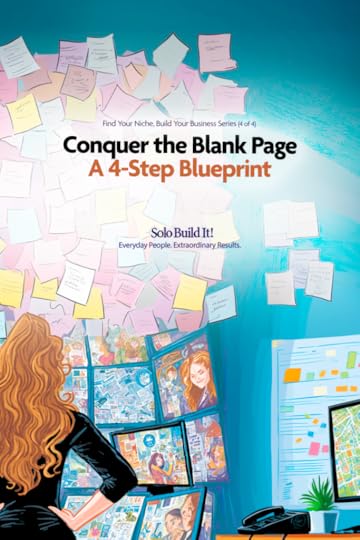 save pin for later
save pin for later 
Those naturally become her article’s main points:
1. Choose Your Herbs WiselyExplain which herbs are easiest for beginners, thrive in different sunlight conditions and are most useful for cooking. Example: basil, mint, chives and parsley.
2. Give Your Herbs a Good HomeGuide readers on choosing pot sizes, drainage and starter kits. Include simple recommendations or checklists.
3. Master the Basics of Sun, Water and CareCover daily watering routines, how to protect plants from wind and basic pest prevention. Keep instructions simple and confidence-building.
Improve Page Experience With These ElementsA good page experience is important for both search engines and AI search and answer tools because it helps make your content easy to find, understand and use.
Search engines treat it as a ranking factor, while AI search and answer tools can more easily spot and reference trustworthy sources for their summaries and answers. In short, a clean, well-structured page makes life easier for both people and algorithms.
Include these elements in your articles where possible, to improve page experience.
Add a short “Quick Tips” list under each point.Use bullet points and subheadings.Add related keywords naturally (i.e., “beginner balcony gardening tips,” “best herbs for containers,” “herb garden care basics”).Add an FAQ section at the end of your article.Step 4: Wrap Up With a Motivating Conclusion (The Send-Off)Your conclusion is your friendly nudge forward. Summarize the key points and encourage readers to take their first step.
Grace’s conclusion might say:
You’ve chosen your herbs, picked the perfect pots and learned the basics of care. With this simple plan, you can start your balcony herb garden with confidence. Every gardener starts with a single sprout — and yours begins today.
Add the next step you would like your audience to take. In this example, Grace is addressing those who have chosen their herbs and learned the basics. She might then add a “next steps” recommendation.
Keep your wrap-up short, warm and motivating.
Article Blueprint ChecklistBefore you start writing, build your “article blueprint.” This simple structure will save you hours and help you avoid blank-page paralysis.
Article Blueprint Checklist
Headline: Clear, keyword-rich, promising valueHook: Connect emotionally with reader thoughts and fearsBody: 3–5 main problems/questions answered logicallyConclusion: Brief summary and encouragement to actQuick WinTake 5 minutes to open a new document and type out:
Headline:
Hook:
Body:
1.
2.
3.
Conclusion:
That’s it. You’ve overcome the blank page. 😉
What’s Next: From Blueprint to First DraftTheory is great, but action builds momentum.
Your next step is simple: flesh out your blueprint. Don’t worry about making it perfect. Just write naturally, as if explaining to a friend. You can polish later.
Need a little extra assistance? See how our AI Assistant Tai can help you overcome writer’s block in minutes. It’s free to sign up. Give it a try!
FAQs Writing Your First ArticleQ: How long should my first article be?
A: Aim for 800–1200 words — long enough to be genuinely helpful but not overwhelming.
Q: What if I’m not a strong writer?
A: Focus on clarity rather than perfection. Structure and genuine value matter more than style in the beginning.
Q: Can I use AI tools to help me write?
A: Absolutely. Use them for brainstorming headlines, drafting outlines or editing. But keep your unique voice and experience at the core.
Q: Do I need to include keywords in every section?
A: No, just use them naturally. One or two keyword phrases in the headline, intro and a subheading is usually plenty.
Our 4-part niche website series was designed to get you from zero to a concrete, actionable content plan for your online business.
This method is just one of many proven processes you’ll find inside the Solo Build It! Action Guide — your step-by-step roadmap for turning your niche and content plan into a real, traffic-generating online business.
You’ve chosen your niche. You’ve found your first topic. You’ve built your blueprint.
Now… it’s time to write!
Missed Any of the Previous Articles? Here You Go!
Part 1: How to Test Business Niche Ideas… Until One FitsPart 2: Part 3: From Keyword to Content Idea: Listen Before You WritePart 4: Conquer the Blank Page: A 4-Step Blueprint (You’re here!)Want the more great articles delivered straight to your inbox?
Subscribe For FreeEmail Address By subscribing, I consent to receiving emails from Solo Build It!(function($) {window.fnames = new Array(); window.ftypes = new Array();fnames[0]='EMAIL';ftypes[0]='email';fnames[1]='FNAME';ftypes[1]='text';fnames[2]='LNAME';ftypes[2]='text';}(jQuery));var $mcj = jQuery.noConflict(true);
Author information Carol Leather
Carol LeatherCarol Leather is head of content at SiteSell. She started her first successful online business, www.needlework-tips-and-techniques.com, with Solo Build It! in 2006 and it's still going strong. She loves photographing and drawing wildlife. She shares her walks in the English countryside on her new site www.naturewalkswithcarol.com. When she is not busy with all the above, she works on her two art sites! All using Solo Build It!, of course.
|The post Conquer the Blank Page: A 4-Step Blueprint (Part #4 of 4) appeared first on SiteSell Blog - Proven Real-World Advice for Solopreneurs.
October 16, 2025
From Zero to 1 Million Fans: A Community-Driven Success Story
I feel like I’ve been able to be a better spouse, parent, and child with the flexibility in managing my time that being the owner of an online business provides.Taylor Flanery, www.home-storage-solutions-101.com
This quote by Taylor Flanery sums up, in a perfect way, the rewards an online business can provide, beyond just money.
Of course, money is nice, too. In Taylor’s case, her business allowed her and her husband to quit their jobs just a few years into her online business journey with Solo Build It!.
Now, 10 years after we first interviewed her, I was curious: Does her home storage and household management business still provide for her family of five?
How has she dealt with inevitable challenges, like major Google algorithm updates, declining reach on social platforms, or income fluctuations?
Some of her answers will probably make you nod along, and others may surprise you, as they did me. One thing’s for sure: you’ll walk away from her interview inspired and with more than a few valuable lessons.
1. Taylor, it’s been nearly a decade since our last interview. Back then, you had successfully transitioned from attorney to full-time online business owner. Please share how your business and your life have evolved since then, especially as you’ve grown into a major community leader in your niche.I’m still a full-time online business owner, and I couldn’t be more thrilled to have had the privilege for the last decade to support my family with my business income while also being able to set my own schedule each day.
As an attorney, with small children, I really struggled with how to juggle my family life and work, feeling like I didn’t have enough time with my kids or for my career. There were several years where I worked full time, and did my SBI! sites as a side-gig, and that was its own brand of tough.
However, once I was able to transition to full-time work on the sites, with my business income enough to fully support my family, it opened a new level of flexibility for me and my whole family that I’ve truly appreciated for the past decade.
It’s not been easy, but being my own boss has allowed me the flexibility to focus on raising my kids while also bringing in an income to support us all.
I’ve been able to stop work and go to tennis matches or other school activities during the school year, take multi-week vacations and travel trips with the family in the summer or during breaks.
 Taylor enjoying a local baseball game with her dad and two of her kids.
Taylor enjoying a local baseball game with her dad and two of her kids.I’ve used the mini-van as a mobile work space as we traveled down the road, and generally got to enjoy time with my family when I wanted and needed to.
It has even allowed me to spend a few days to a week at a time, on multiple trips, at my elderly parents’ house, out of state, to help them declutter their house and get ready to move up closer to me, while still managing my business in the evenings using my laptop.
I feel like I’ve been able to be a better spouse, parent, and child with the flexibility in managing my time that being the owner of an online business provides.
The business has also become a family affair during this time period. My husband works with me daily, and has for many years at this point, doing administrative tasks as well as being in charge of mailing out the printed products we sell.
In really busy seasons (especially around the holidays) or when big projects hit, a couple of my kids have also pitched in to help with various admin or technological tasks, to keep up with sales and marketing.
That helps everyone in the family understand the business and the time and skills it requires, which is an added bonus.
TAKEAWAY #1: A decade later, what’s the biggest evolution in Taylor’s business? It’s not just the income; it’s the profound level of freedom and flexibility she has designed for her life.
Her story is such a great example for the “why” that drives so many of us. She has built a business that allows her to be present for what matters—attending school activities, taking multi-week family vacations, and caring for her elderly parents.
I especially love this part:
“I feel like I’ve been able to be a better spouse, parent, and child with the flexibility… an online business provides.”
This is the real measure of success for being a business owner. It’s not about escaping a 9-to-5 just to work 24/7 for yourself. It’s about creating a business that serves your life, not a life consumed by your business. (Although this remains a challenge for her, as she admits in her answer to question #9.)
 save pin for later
save pin for later 
I’m still finding my footing with the changes to my site’s traffic, but I feel like I have options and pathways to success, and that’s important.
Each year I’ve watched with interest how the business evolves and changes, as I introduce new income streams, while old ones become less important. So in some ways this latest change is just more of the same, although it is, admittedly, more challenging than others.
Online business is such a new type of business, with the technology and platforms changing so quickly. For example, in the beginning I used to make most of my money from Google AdSense, then it was affiliate income, and now it’s expanded to include my own products.
Today I have several income sources within the mix and they all have their place. The same thing can be said about traffic sources — they change and evolve over time.
The important thing is to keep evolving, growing, and trying to figure out what my audience wants and needs, and then provide it to them. That’s what I’m working on yet again with these changes in the market, and we’ll see how it goes.
I will also add that the best thing I did for my business was a constant focus to grow and sustain my email list.
This has allowed me, even when there were dips in traffic from other sources, to consistently connect with my readers and share articles and links to my sites, as well as information about sales and products.
In my opinion you can’t have a sustainable business without an engaged email list.
TAKEAWAY #2: Taylor’s response to the traffic challenges teaches us an important lesson: She doesn’t panic; she puts it in perspective.
She sees this latest challenge as just another evolution in a constantly changing business. Her income streams have shifted over time, and so have her traffic sources. This isn’t a catastrophe; it’s the nature of the game.
But her most crucial point is this: the best thing she ever did was grow and sustain her email list.
So, if you haven’t started building your email list yet, get going! It’s the one asset you truly own and control. It provides you with a direct line of communication with your audience, completely independent of unpredictable search engine algorithms or social media platforms.
As Taylor says, it’s what allows her to “consistently connect with her readers” even when traffic from other sources dips. An engaged email list isn’t just a marketing tool; it’s your business’s ultimate safety net.
In December 2024 I celebrated my 10th anniversary of the creation of the Declutter 365 public Facebook group.
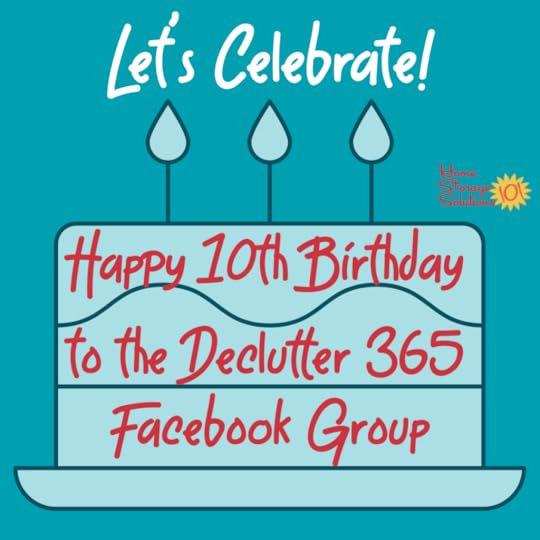 10 years and over 1 million members. That calls for a celebration!
10 years and over 1 million members. That calls for a celebration!I’ve been active in that group basically every single day for the past 10+ years. Holidays, weekends, during vacations. Every. Single. Day. This consistency contributed to its growth, with me showing up and engaging with people over and over.
It’s a public group, so the posts can show up on friend’s feeds, as well as a recommendation when Facebook’s algorithm thinks someone may have that specific interest.
I can’t take credit for the luck that happens when the algorithm gods recommend the group, but it’s like the saying goes… all my preparation allowed me to be ready for those lucky times, and helped the group to grow.
When you have a large group like this though, it can easily become its own lumbering giant, and a time-suck instead of a business asset.
I’ve had to work hard to keep it as a business asset that allows me to promote my products for two reasons:
One, there are inevitably people who get offended that I’m advertising my products within the group.
And two, Facebook discourages links to outside sources more and more, as they want users to stay on their platform.
However, I keep promoting my business regularly in comments and posts within the group, and allow those people who don’t like that to find a different place to discuss decluttering.
I must be able to justify the time devoted to managing the group. My time as a solo business owner is limited. I’ve got a full life, and the time I spend on any business task has to contribute to my bottom line, or it’s not worth doing.
TAKEAWAY #3: Growing a Facebook group to over 1 million members is an incredible achievement. There are two key ingredients that contributed to this success: consistency and a business-first mindset.
First, the consistency is staggering: Taylor has been active in the group every single day for 10+ years. Holidays, weekends, vacations—no exceptions. This relentless dedication is what builds trust, fosters engagement, and signals to both members and the algorithm that the group is an active, valuable community.
Second, she’s crystal clear that the group is a business asset, not a hobby. She’s not afraid to promote her products, and she doesn’t cater to members who object to that.
Her reasoning is something every solopreneur should write on a sticky note:
“My time as a solo business owner is limited… the time I spend on any business task has to contribute to my bottom line, or it’s not worth doing.”
Whether it’s a Facebook group, a forum community, or a YouTube channel, you must be able to justify your time investment. Building a huge audience is great, but if it doesn’t support your business goals, it’s just a time-consuming hobby.
Yes, my husband and I both still work full time in the business. I actually work about 35 hours a week (and a bit more during busy periods like Q4 through the beginning of each calendar year), while my husband works about 15-20 hours a week (plus more during this same busy period).
It’s very flexible for us, which we both really appreciate. As I mentioned above, my monetization has shifted, and it seems to have different proportions year after year, so it’s important to stay flexible and keep doing more of what’s working at any given moment.
My monetization is still a mix of advertising, affiliate sales and selling my own products. At first, I sold only digital products, including memberships and subscriptions. In the last few years, I’ve added physical printed products to the mix, which we mail to customers.
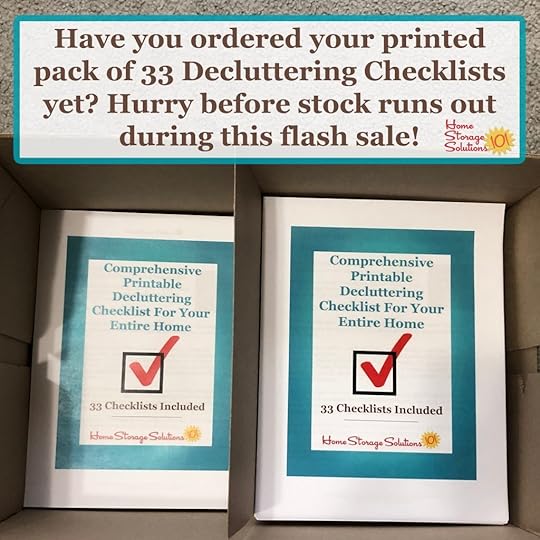 A smart move to diversify your income stream: Taylor added printed, physical products to her monetization mix.
A smart move to diversify your income stream: Taylor added printed, physical products to her monetization mix.TAKEAWAY #4: Taylor’s monetization strategy is a perfect example of how a business grows and adapts over time.
Like many Solo Build It! members, she started with a classic mix of advertising and affiliate sales. Then she moved into selling her own digital products, a key step for growing your income. Now, she’s even added physical printed products to the mix.
This multi-faceted approach is a smart way to diversify your income and build a more resilient business. As the saying goes… “Don’t put all your (monetization) eggs into one basket.” You’re not reliant on just one income stream, which protects you from market shifts and algorithm changes.
Another takeaway is Taylor’s flexibility. She notes that the proportions of her income change year after year, so she stays focused on “doing more of what’s working at any given moment.”
This is an important ingredient for long-term success. Don’t get complacent. Stay flexible, test new ideas, and lean into what’s delivering results right now.
The premium group membership has been around for seven years. It enabled me to do more video group coaching for members, which led to lots of opportunities to interact with my most loyal customers and build a vault of coaching material.
I used to do weekly video sessions. A couple of years ago I switched to monthly sessions, because weekly was becoming too much.
This membership model added an additional, recurring revenue stream to the income generated from our product sales.
While the recurring revenue is great, I’m currently contemplating how to offer the membership in the future. I need to re-assess whether the income it generates justifies the time it takes to maintain the premium group.
I’m also trying to figure out trends in the industry of what customers want in a membership. All this to say that this offer is potentially in flux this coming year, although nothing has been decided yet.
TAKEAWAY #5: Taylor’s premium membership is a real-world look at this popular monetization model.
The benefits were clear: a deeper connection with her most loyal customers and a predictable, recurring revenue stream.
The challenge? A membership model is not a “set-it-and-forget-it” monetization option. It demands a significant, ongoing time commitment. Taylor has already adjusted from weekly to monthly coaching sessions and is now re-assessing if the income justifies the time.
This is the key takeaway for anyone considering adding a membership to your monetization mix. The recurring revenue is attractive, but you must be ready for the long-term work. Regularly evaluate, just as Taylor is doing, to ensure the model still serves both your audience and your business goals.
I started a redesign several years ago, which never came to fruition (through my own fault, because family issues became too big to keep up and finish the project).
I really need to get back to that redesign, because I think it would help to update the look and feel of the sites. The last few years have just been very busy, and it hasn’t happened.
TAKEAWAY #6: Taylor is honest about her site’s classic design—it’s not a deliberate branding choice; a redesign simply hasn’t been a priority for her.
Some people criticize Solo Build It! for not having the most modern website templates with all the bells and whistles. Taylor’s story proves, once again, that design is not the main success driver.
Taylor’s success is built on the quality of her content, her deep connection with her community, and a monetization strategy that works. The “look and feel” is secondary to the value she provides.
Don’t let the pursuit of a “perfect” design stop you from focusing on what truly matters: creating great content and providing the solutions your audience wants and needs.
How do I keep up? I don’t, unfortunately.
While I love all three of my sites, I’ve focused on Home-Storage-Solutions-101 for many years since that’s the site which is generating the bulk of my income, while the others have sat mostly idle.
I’ve also developed a lot of systems to keep the administrative portions of the sites moving forward. There are systems and processes for social media scheduling, administering the groups, working on the editorial calendar, updating and sending out content, as well as for writing email newsletters regularly.
My editorial calendar includes not just content, but also marketing, for example for doing affiliate promotions and marketing and selling my own products.
I don’t currently use any AI within my business.
TAKEAWAY #7: “How do I keep up? I don’t.”
I had to chuckle when I read Taylor’s honest answer. Don’t we all feel like that? When you build your business as a solo entrepreneur, it’s impossible to do everything.
Taylor realized that and rather than spreading herself thin, she concentrates her energy on the one site that delivers the most value.
She relies on proven systems and processes to keep the administrative parts of her business moving, not on trying to do it all herself.
I also asked her why she isn’t using AI. She feels that AI can’t provide the accurate information her customers need, and that instead she relies on her 10 years of experience in her field.
We agree one hundred percent that your experience has to be at the core of your business strategy. However, we also believe that tools like our own AI assistant, Tai, can help to lighten some of your workload as a content creator. It can also serve as an excellent sparring partner for new ideas.
I’m quite selective when it comes to summits and conferences, and only participate in those that I enjoy and that help me get exposure with new audiences who are interested in my topic, like for example the recent “Get Organized HQ.”
These conferences help me network with other business owners within my niche, or related niches, and this can lead to more business opportunities and collaborations.
And finally, I choose conferences and summits where I believe in the quality of the presentations and information offered, because I then can also be an affiliate for these events.
This leads to a triple win for me: exposure to new audiences, collaboration and networking with other business owners, and income through affiliate sales.
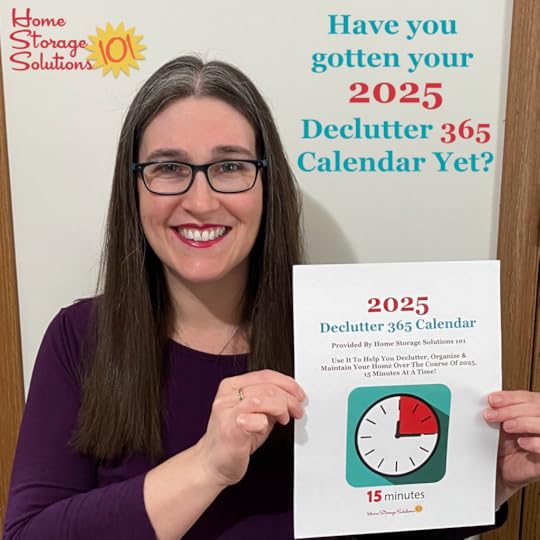 Decluttering your home in 15 minutes a day. Who wouldn’t want that?
Decluttering your home in 15 minutes a day. Who wouldn’t want that?TAKEAWAY #8: Taylor is very strategic about collaborations like the “Get Organized HQ” conference. She doesn’t say “yes” to everything. Her approach provides a smart checklist for any solopreneur.
She only participates if the event delivers a “triple win“:
Exposure: It gets her in front of a new, highly relevant audience.Networking: It connects her with other business owners for future collaborations.Income: She can also earn money as an affiliate for the event.This is a fantastic framework to use for your own business. Before you agree to any collaboration or speaking engagement, ask yourself: Does it offer exposure, networking, and a potential income stream? By being selective, Taylor ensures that her time investment always delivers a significant return.
I love to be in control of my own schedule, and being an online entrepreneur allows that. It is wonderful to be able to head to an exercise class mid-morning, or take a walk, or throw in a load of laundry as needed.
I can also go to activities with my kids for school or sports, or just take a long lunch break with my husband. I love all those freedoms that being my own boss gives to me.
On the other hand, being an online entrepreneur, as with any business, also means that you work without much of a safety net. If you get sick or want to take a vacation, you still need to make sure the work gets done somehow, or accept the consequences of it not getting done.
It has also been hard to wrap my head around the concept that the amount of work I do is not directly related to my compensation.
I’ve had to learn to work smarter, not harder, because some things bring in more revenue or get better traffic than others, and I need to make sure I am not wasting time or effort on low return tasks.
I know that if I’m not careful I could work and work and work, all the while forgetting to take the necessary downtime to avoid burnout.
 Taking a break: Taylor and husband Josh on vacation in New Orleans.
Taking a break: Taylor and husband Josh on vacation in New Orleans.TAKEAWAY #9: Taylor’s answer perfectly captures the two sides of the solopreneur coin.
On one side, the reward: freedom and control over your own schedule. As we saw in Takeaway #1, this is the core of Taylor’s success story.
On the flip side of that freedom: there is no safety net. You are responsible for everything, and the work is always there. This brings us back to the point I mentioned in the first takeaway—Taylor’s ongoing challenge of not letting her business consume her life.
She shares a critical lesson:
“I’ve had to learn to work smarter, not harder, because some things bring in more revenue… and I need to make sure I am not wasting time or effort on low return tasks.”
This is the key to sustainable solopreneurship. It’s not just about putting in the hours; it’s about putting your hours into the right things.
I mentioned this above, but for me, I believe that the most important thing for website owners to do is start and maintain an email list, and that email list needs to point to a website that you own (as opposed to just pointing to social media, where your account is precarious and not within your control).
The email list needs to be growing consistently, and you need to have a mix of relationship building content along with occasional content designed to market and sell your products, services, or otherwise make some money to sustain your business.
This allows you to weather the ups and downs of social media and search algorithms better, and to build trust and relationships with people to help them find quality solutions to the issues your business addresses.
TAKEAWAY #10: I’ll be honest, this answer surprised me. Given Taylor’s massive success on Facebook, I expected her final piece of advice to be about social media.
Instead, her #1 recommendation for building a sustainable business is to start and maintain an email list.
This is a valuable lesson from someone who has mastered both. She knows that while social media is great for reach, it’s a platform you don’t control. As she says, your account is “precarious.”
Your email list, however, is an asset that you own (like your website).
It’s your direct, reliable line of communication to your audience, independent of unpredictable algorithms. It allows you to build deep trust and relationships over time. And it gives you a stable platform to market your business through all the ups and downs of search and social trends.
TL;DR? Here are the key lessons from Taylor’s SBI! success story.
How Do You Build a Long-Term, Profitable Online Business in Any Niche?Design Your Business to Serve Your Life: Taylor’s business is a tool that enables her to be present for her family. By prioritizing flexibility, she has built a successful career that fits her life, not a life consumed by her career.Own Your Audience With an Email List: Despite her massive social media following, Taylor’s number one piece of advice is to build your email list. It’s the only asset you truly control, making it the ultimate safety net against unpredictable algorithm changes.Build a Community With Purpose: Her 1-million-member Facebook group isn’t a hobby; it’s a business asset. She built it with relentless consistency and a clear understanding that her time investment must contribute to her bottom line.Evolve and Diversify Your Income: Taylor didn’t stop at AdSense. Her income grew as she evolved from ads to digital products, then to a premium membership, and even physical products. This diversification creates a more stable and resilient business.
Taylor’s story shows what’s possible when you combine passion with consistency and a proven process. She is just one of thousands of “everyday people” who have built successful, life-changing businesses with Solo Build It!.
Want to learn from more SBI! Success Stories?
If you found Taylor’s story inspiring, sign up for our free 10 Real Life Success Lessons email series. Each day, you’ll meet another successful SBIer and discover a unique, actionable lesson to help you on your own online business journey.
Author information Margit Streifeneder
Margit StreifenederMargit Streifeneder is the Marketing Co-Director at SiteSell. She works with a small but mighty team to spread the word about Solo Build It!, via helpful content, informative emails and eye-catching ads. She's passionate about helping solopreneurs achieve success, and enjoys interviewing SBI! members about their achievements. Besides growing her own online business, she loves exploring new places, hiking, dancing and spoiling her four cats.
|The post From Zero to 1 Million Fans: A Community-Driven Success Story appeared first on SiteSell Blog - Proven Real-World Advice for Solopreneurs.
October 3, 2025
From Keyword to Content Idea: Listen Before You Write (Part #3 of 4)
One of the most exciting steps in building an online business is moving from research to writing. You’ve brainstormed niches and completed keyword research to confirm the best niche for your interests and potential for profit. Now comes the part that transforms those keywords into content your audience truly wants.
This article is Part 3 of our series on choosing and developing your niche. We’ll show you how to take a keyword from your list and uncover the real problems and questions people have behind it. By the end, you’ll know how to turn a single keyword into multiple article ideas that both humans and search engines will love.
From Keyword to Content IdeaYou’ve built a master list of niche-focused keywords. This isn’t just a list of words; it’s a treasure map filled with the exact topics your audience is searching for. It’s one of the most valuable assets for your new business.
You have also , like our friend Grace did with CitySprouts.com, and designed your site template.
Now, you pull up your keyword list, find a promising term like Grace’s “balcony herb garden,” and open a blank page to start writing.
And… you freeze.
What’s the best title?What specific problem should you solve?What are the burning questions people really have about that keyword?Your treasure map points to the treasure, but now you need to figure out exactly where to dig. In other words, how to you go from keyword to content idea.
This is where you bring your keyword research to life. Your mission is to take a keyword and find the human stories and urgent questions behind it.
Four Simple “Eavesdropping” TechniquesHere are four ways to peek into your audience’s real conversations and uncover content ideas.
1. Use Forums Like Reddit to Find Real Audience QuestionsOnline forums are a goldmine of raw authentic, honest questions. Grace heads to Reddit and searches for “balcony herb garden” in communities like r/UrbanGardening and r/CommunityGardening.
She’s not looking for generic questions; she’s looking for pain points – something she can answer based on her own unique experience. In just a few minutes, she finds people asking:
“Help! My mint is taking over my entire planter box. What did I do wrong?”“What are some herbs that can actually survive a hot, full-sun balcony all day?”“My basil keeps getting tiny white bugs under the leaves. Is it doomed?”Try this in your own niche. If you’re interested in photography for example, you might find threads like “Best SLR cameras for beginners” or “How do I take pictures in low light without a tripod?”
2. Search Amazon Q&A for Content Gaps and IdeasNext, Grace goes to Amazon and looks up a popular book on container gardening. She skips the reviews and scrolls straight down to the “Customer questions & answers” section.
This reveals what information people felt was missing before they were willing to buy. She finds:
“Does this book have a section on dealing with common pests for balcony plants?”“I have a very small space. Does it explain exactly how deep the pots need to be for different herbs?”“Is this guide suitable for someone with a low-light balcony?” save pin for later
save pin for later  3. Use AnswerThePublic for a Visualization of Real Searches
3. Use AnswerThePublic for a Visualization of Real SearchesGrace then tries AnswerThePublic.com. She types in “balcony herb garden” and gets a visualization – a wheel of questions people are asking. Think of it as a mind map of the internet’s brain.
She immediately spots questions like:
“Can a balcony herb garden attract bugs?”“How to protect a balcony herb garden from wind?”“What are the best low maintenance balcony plants?”4. Use Google Autocomplete to Spot Trending SearchesFinally, Grace uses the simplest tool of all: the Google search bar. She starts typing “balcony herb garden” and lets autocomplete reveal what others are searching for:
balcony herb garden kitbalcony herb garden for beginnersbalcony herb garden winterbalcony herb garden planterHow to Turn Keywords Into Content Ideas for ArticlesIn less than 30 minutes, Grace hasn’t just stared at a keyword. She’s listened to her prospective audience. Now, instead of feeling frozen, she has a list of powerful, specific article ideas, each one solving a real problem.
A Beginner’s Guide to Your First Balcony Herb GardenThe 5 Best Herbs for a Hot, Sunny Balcony (And How to Care for Them)Do Herb Gardens Attract Bugs? (And How to Keep Pests Away)How to Protect Your Balcony Garden from Strong WindsWinter Is Coming: A Simple Guide to Caring for Your Herbs in the ColdUnderstand Search Intent Before Choosing a TopicGrace’s list of ideas is fantastic. But which one should she write about first? This is where we add one last, simple layer of thinking: understanding search intent.
Search intent means the reason behind a search – whether someone wants to learn, compare, or buy.
Someone searching “balcony herb garden for beginners” wants to learn.Someone searching “balcony herb garden kit” may be looking to buy.As a new site owner, the fastest way to build trust is to focus on questions where the searcher’s goal is to learn. These are the “how-to,” “what is,” and “beginner’s guide” type searches. By answering them, you become a helpful, trusted guide.
So, Grace looks at her list and sees a clear winner for her first article: “A Beginner’s Guide to Your First Balcony Herb Garden.”
Your Action StepLook at the list of article ideas you just generated. Circle the top 2 – 3 that are clearly about helping and teaching. Choose the one that feels most exciting to you. That’s your target for your first article.
You Have Your Topic – It’s Time to BuildCongratulations! You’ve listened to your audience, found the real questions behind the keywords and selected a powerful topic for your first content page.
This is a critical moment where going from keyword to content ideas turn into assets for your business.
Next, you’ll take that fantastic “Beginner’s Guide” or “How-To” topic you just uncovered and build it into your first cornerstone page.
FAQs About Listening Before You WriteQ: What is search intent and why does it matter?
A: Search intent is the reason behind a search — whether someone is looking to learn, compare, buy or visit a specific website. Matching your content to intent makes it more helpful and increases your chances of ranking.
Q: What tools can I use to find content ideas?
A: Some of the best free tools are Reddit (forums), Amazon Q&A, AnswerThePublic, and Google Autocomplete. Paid keyword tools can add more depth, but these free ones are often enough to get started.
Q: How do I know which keyword to write about first?
A: Start with keywords where the goal is to learn. Beginner-friendly, how-to and problem-solving searches build trust and establish your site’s authority.
What’s Next?This was Part 3 of our 4-part series on choosing your niche and turning it into an online business.
Part 1: How to Test Business Niche Ideas… Until One FitsPart 2: Part 3: From Keyword to Content Idea: Listen Before You Write (You’re here!)Coming Soon
Part 4: Laying the Foundations for Long-Term GrowthStay tuned for the next article, where we’ll build a solid foundation for your online business.
Want the next article delivered straight to your inbox?
Subscribe For FreeEmail Address By subscribing, I consent to receiving emails from Solo Build It!(function($) {window.fnames = new Array(); window.ftypes = new Array();fnames[0]='EMAIL';ftypes[0]='email';fnames[1]='FNAME';ftypes[1]='text';fnames[2]='LNAME';ftypes[2]='text';}(jQuery));var $mcj = jQuery.noConflict(true);
Author information Carol Leather
Carol LeatherCarol Leather is head of content at SiteSell. She started her first successful online business, www.needlework-tips-and-techniques.com, with Solo Build It! in 2006 and it's still going strong. She loves photographing and drawing wildlife. She shares her walks in the English countryside on her new site www.naturewalkswithcarol.com. When she is not busy with all the above, she works on her two art sites! All using Solo Build It!, of course.
|The post From Keyword to Content Idea: Listen Before You Write (Part #3 of 4) appeared first on SiteSell Blog - Proven Real-World Advice for Solopreneurs.
September 25, 2025
Six Figures on Her Terms: A Lifestyle Business Success Story
The freedom to work the hours that work best for me and my family and being able to set my hours the way it works best for me will NEVER get old. I love that freedom. Cheryl Hatch, www.preschool-plan-it.com
Cheryl’s journey to this kind of freedom began long before the internet, back in the 1990s. As a preschool teacher and director, she wore many hats and saw a common frustration among her peers: they spent hours scouring different websites for lesson plans, often with little to no budget.
The idea to share her own two decades of saved materials started as a plan for printed booklets, but life—and a full-time career—put it on the back burner.
The “aha!” moment came years later, in a conversation with her daughter, who suggested a wild idea: build a website.
Cheryl’s reaction: “ME? Build a website?…(cue cricket sound)”
That suggestion sparked a journey that led her to Solo Build It! and the creation of Preschool Plan It, a site designed to solve that core problem for teachers. When I first interviewed Cheryl in 2015, she had already turned her passion into a growing work-from-home business.
Ten years later that business has evolved in ways she never imagined. In this follow-up interview, Cheryl shares how she went from selling a few digital products to running a six-figure business with a membership program, all while designing a life with the freedom that never gets old.
Let’s dig in!
1. Cheryl, it’s been a decade since our first interview. As you reflect on your online business journey, please share a few highlights—the good, the bad, and the ugly—and how your original motivation of being a work-at-home mom has evolved along with your family.Well, there certainly has been all of that—the good, the bad, and the ugly! As my preschool site’s traffic grew, so did the emails from subscribers. They were looking for more help with lesson planning and training. So, I added some digital resources and eventually a monthly membership. That was the good.
The bad—I didn’t know how to create online products or create email marketing funnels… all the tech stuff… and that’s the ugly to me—the tech stuff. However, we can learn anything online, and with the help of a marketing person, I learned that I could figure out what I needed to know and that I could get the help of others for the parts I didn’t know.
I’m incredibly grateful to have the online business that I have. Ten years ago it allowed me to do what I had hoped for at that time—spend time with my adult daughters based on their busy work and college schedules. I was able to plan my work time around their schedules. And it allowed me to spend lots of time with my new grandson.
Since then, our family has grown and changed. My husband is now retired, and we now have two grandchildren. Working for myself allows me to plan my work so my husband and I spend lots of time enjoying his retirement, and it allows me to plan my work around when the kids and grandkids are available.
For example, I take school vacation weeks off so I can spend time with them. I take lots of time off in the summer for lots of family sleepovers!
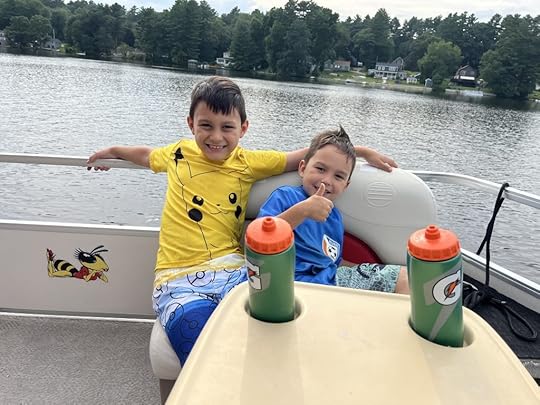 Spending time with their two grandsons—a precious gift for Cheryl and her husband.
Spending time with their two grandsons—a precious gift for Cheryl and her husband.TAKEAWAY #1: “The good” in Cheryl’s journey came directly from listening to her audience. Her business grew from a simple content site to one with digital products and a membership because her readers asked for it.
Take this golden rule to heart: solve your audience’s problems and your business will thrive.
And “the ugly”? For her, it was the tech stuff—a major hurdle for so many people. Her lesson is an important one: you don’t have to be a tech genius. You can learn what you need and get help for the rest. This is a core reason why Solo Build It! exists—to provide an all-in-one platform that simplifies the tech so you can focus on your business.
The most compelling part of Cheryl’s story is how her “why” has always revolved around freedom. Her business has consistently given her the freedom to put her family first—from being there for her daughters to now enjoying retirement with her husband and spending priceless time with their grandsons.
This is the ultimate goal for so many of us: building a business that serves our lives, not the other way around.
I would not change a thing! Preschool Plan It does exactly what I’d hoped it would do—serve preschool teachers and the children in their care while providing an income!
It did teach me that it’s important to really go through the SBI! Action Guide step by step. I am applying the Action Guide to the development of my new sites— Toddler Plan It and a third site (still in the research stage—it’s about a specific genre of books and book reviews).
Because it’s been a few years  since I went through the Action Guide, I decided it was important for me to go through it again from the start to remember what I may have forgotten, and I’m glad I’m doing that.
since I went through the Action Guide, I decided it was important for me to go through it again from the start to remember what I may have forgotten, and I’m glad I’m doing that.
Some things have changed regarding how keywords work on sites for SEO purposes and there’s great advice on making the user experience of your site the best it can be.
TAKEAWAY #2: When we look back at our decisions in life, Cheryl’s statement is the ultimate answer: “I would not change a thing!” That’s the sign of a business built on passion and a solid foundation.
So, why is a successful 15-year veteran going back to the very beginning of the Solo Build It! Action Guide for her new sites?
Because the online world is in constant motion, now faster than ever with the advent of generative AI and AI search.
Best practices for things like keywords, domain names and site structure are different than they were 15 years ago. What hasn’t changed though is to always put your human visitors first. Never create content just to please search engines.
This is where the SBI! Action Guide shines. It’s both the keeper of the timeless online business basics and a dynamic resource, constantly updated by our team.
Both actually! I am a planner. I think it may be in my DNA, lol. I like to know what I’m working on each week. I used to just fill in my calendar with what needed to get done.
Over time I’ve realized that batch processing (doing similar tasks in the same day) is much more effective than breaking it up over the month. For example, I create the content for my membership on one day. I then create the deliverables and printables on a different day.
So, I’m all in with content creation in one day and then can work on visual creation on another.
My schedule has changed over the years as I’ve become more effective by streamlining/batching the work that I do.
I have two schedules. I have a school-year schedule (September through May) and a summer schedule.
September through May I work three days a week (Tuesday, Wednesday and Thursday) three weeks a month. That’s right—I take a week off every month.
Week 1: I work on Preschool content: I create and schedule my email marketing and newsletters for the following month for my free list and for my members and I create the two pieces of content for my members.
Week 2: This is marketing and sales week. It’s the week I create any new email marketing funnels, new products, updates to the website, etc.
Week 3: This is the week I work on my other two sites (the toddler site and the book site).
In the summer I only work on the preschool site, and I only work on Tuesdays (because I will NOT miss an SBI! Zoom call if I can help it!). That means I work on everything preschool (from Week 1 of the above schedule) on Tuesdays and have Wednesday through Monday off every week during June, July and August.
 “Is it our week off?” wonders Jack, the “dog with a blog” and Cheryl’s faithful business assistant.
“Is it our week off?” wonders Jack, the “dog with a blog” and Cheryl’s faithful business assistant.TAKEAWAY #3: LOL. Cheryl is indeed a planner. I wonder if her talent has anything to do with her sites’ topics?

Many of us dream of freedom, and Cheryl shows us what it looks like in practice: a highly structured, intentional schedule designed to maximize both productivity and personal time.
Her secret weapon? Batch processing. Instead of scattering different tasks throughout the week, she dedicates entire days to specific functions—one day for membership content, another for marketing, another for her new sites. This is a proven method to reduce mental clutter and get into a state of deep work.
But what I find most inspiring is how she builds her life first, then fits her work into it.
She works just three days a week, three weeks a month.She takes a full week off every single month.In the summer, she works only on Tuesdays.Cheryl has perfected the holy grail of every online business owner: build a life you love while making good money.
Oh, and by the way, the Zoom calls she’s so keen on attending? These are the live Q&A sessions every SBI! member has access to. They’re perfect for getting your questions answered on the spot, learning something new and mingling with your fellow online-business owners.
I don’t use AI for content creation. I have a hands-on philosophy for lesson planning. AI tends to generate more cookie cutter stuff. I also LOVE planning activities, so I don’t want to outsource that.
I am intrigued about AI though (even though I have very, VERY little knowledge/experience in it). This fall I will be going through the Tai Guide to learn all about it.
During one of the recent SBI! Zoom calls we were talking about Tai. I’m excited about all I’ll be able to use it for from business planning, to content ideas, to SOPs.
I have so many Standards of Operation for each task in my business that I’ve written over the years, and I think AI will help streamline that process somehow.
TAKEAWAY #4: I love Cheryl’s approach to AI. As a hands-on expert who is passionate about her craft, she has no interest in outsourcing her core content creation to AI—and she shouldn’t! AI can’t replicate true passion or deep, hands-on experience.
However, she’s not dismissing it either. She recognizes AI’s potential for other business tasks like planning, idea generation, and creating Standard Operating Procedures (SOPs).
This is a smart and balanced approach that we teach in the Tai Guide. You don’t have to use AI for everything. The key is to identify where it can save you time on administrative or supporting tasks, freeing you up to focus on the high-value, human-centric work that only you can do.
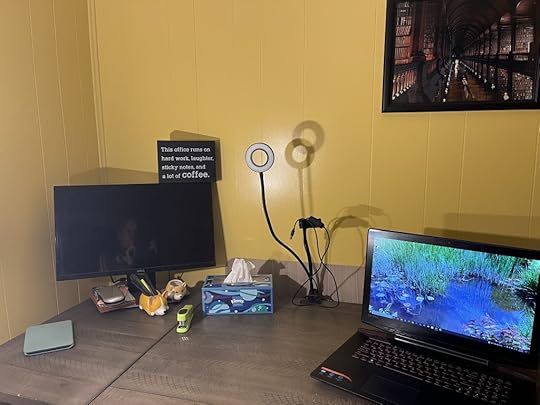 Cheryl’s indoor office space, where she creates all that valuable content for her audience.5. In 2016, you launched the “Preschool Cubby” membership program. How has this move to a recurring revenue model impacted your business in terms of income stability and your ongoing time commitment?
Cheryl’s indoor office space, where she creates all that valuable content for her audience.5. In 2016, you launched the “Preschool Cubby” membership program. How has this move to a recurring revenue model impacted your business in terms of income stability and your ongoing time commitment?The membership has been great. Many teachers were asking for more involved lesson planning (more than what the website offered), so I created a membership where they can choose the four weekly themes they want each month.
It has definitely helped with income stability. At this point I know that the average member stays with the membership for two years so I can plan based on that.
In terms of time commitment, it doesn’t take more time because most of my website content on Preschool Plan It is evergreen. Therefore I don’t need to continually create new pages. That time is spent now on creating content for the membership.
 Part of Cheryl’s sales page for her membership program.
Part of Cheryl’s sales page for her membership program.TAKEAWAY #5: Cheryl touches upon the key benefit of the membership model: income stability.
Because she knows the average member stays for two years, she can forecast her revenue and plan her business with a level of predictability that’s difficult to achieve with one-off product sales or fluctuating ad revenue.
Her answer regarding the time commitment surprised me. Usually, a membership is rather time intensive, as you continuously have to provide new content for your members.
Due to the evergreen nature of Cheryl’s website content, she was able to simply shift her time from writing new web pages to creating materials for her “Preschool Cubby” members.
Does your topic lend itself to a membership? It’s worth looking into it.
This is such a great question to reflect on! When I started my first website with SBI! my goal was to make maybe $300-$500 a month. My monetization plans were to run ads on my site and use affiliate links. That’s what I did until about 2014.
In 2015 I added digital downloads teachers could purchase. With that model, the income was about $1,800 a month—far more than I had planned or dreamed!
Then teachers started asking for more detailed help with lesson planning. Someone told me that my site “just screamed membership.” Well, I had no idea what that might even look like.
After much discussion and planning I launched the membership in 2016 and that took the revenue up to approximately $5,000 a month (my membership is NOT expensive—It’s $17.99/month or $172 a year).
Today, my monetization mix is still the same: ad revenue, digital products, affiliate links (mainly Amazon) and the membership. The business is now a six-figure annual business.
TAKEAWAY #6: Cheryl’s monetization journey is a perfect illustration of how an online business can grow and scale over time.
It started with a modest goal: $300 to $500 a month from ads and affiliate links. For many, that alone would be a huge success.
Then came the first big step: she listened to her audience and started creating and selling her own digital products. That move tripled her income to around $1,800 a month.
But the real game-changer was the membership. Again, she listened to her audience’s needs and created a recurring revenue stream that took her income to $5,000 a month and eventually helped her build a six-figure business.
I find Cheryl’s story so motivating and reassuring: You don’t need to have it all figured out on Day 1. Start simple, listen to what your audience wants, and progressively add more valuable (and profitable) income streams as your business matures.
 save pin for later
save pin for later 
Email marketing is EVERYTHING to my business. While I have social media, my email list is what truly makes the difference. It’s how I connect with teachers, provide the information they need, and introduce them to the membership.
My strategy has two main parts: regularly scheduled emails and automated sequences.
For my Regular Emails, I send a few different types:
Weekly Newsletters: These go to my free list with helpful preschool topics and a link back to the full article on my site. This drives traffic, which helps with ad revenue and affiliate sales.Promotional Emails: Three times a month, I offer a low-cost digital product ($6). Many teachers who purchase these eventually convert to the full membership.Member Newsletters: I also send weekly tips to my paying members to help them get the most out of their membership, which is key for retention.Automated Sequences also play a huge role. I have several running in the background based on a subscriber’s actions.
For my Free List: New subscribers get a Welcome Sequence that introduces them to my site and the membership. If they buy a digital product, they get a separate sequence that delivers it and gently nurtures them toward the membership.For my Paid Members: New members receive an Onboarding Sequence during their first month with tips and videos on how to use the membership. I also have retention automations set up to handle reminders for upcoming renewals, failed payments, and expiring credit cards.I LOVE automations! They are a “set it and forget it” system that works for me in the background.
(Important reminder: Don’t forget to review the automations periodically to ensure the information is up to date!)
For those wondering, I use ONTRAPORT for my email marketing, which integrates well with my membership software, AccessAlly. I’ve been with them since 2017 and find their customer support to be to notch.
TAKEAWAY #7: If you haven’t given email marketing much thought for your online business, I hope Cheryl’s enthusiasm inspires you to reconsider. Her statement, “Email marketing is EVERYTHING to my business,” tells you just how important it is.
The benefits are plentiful. You’re connecting with an audience that wants to hear from you. You own your list, so you’re not at the mercy of unpredictable algorithm changes. And you gain valuable insights by seeing which topics your readers are most interested in.
But as Cheryl’s system demonstrates, the real power lies in email automation.
Her automated welcome, onboarding, and retention sequences work for her 24/7 in the background—a “set it and forget it” system that nurtures subscribers and retains members without her daily involvement.
This is what transforms an email list from a simple communication tool into a time-saving engine that drives your business forward.
Sigh. Social Media. I do have a Facebook and Instagram account for the preschool site but honestly, I don’t see much traction from them.
The great thing about social media is you can reach a lot of people.
The not so great thing is social media platforms don’t want you sending people off their platforms so leading them to your website can be a challenge when the reach is being squashed by the platform.
Also, for me, 80%+ of my site traffic comes from organic search (teachers going to search engines like Google to type in what they’re looking for) so I find it best to focus on my website and email marketing.
All that to say, I have Facebook and Instagram but don’t post often on them currently.
TAKEAWAY #8: “Sigh. Social Media.”
Cheryl’s opening says it all, doesn’t it? Can you relate? You know you should have a presence on social, but it often feels like a time-consuming chore with little direct return.
However, not having any social media presence isn’t an option either, not if you want to be perceived as a reputable brand. And, like Cheryl points out, you can reach a lot of people on social platforms.
So, what could be the solution? Outsourcing. If the income from your site allows it, hire a Virtual Assistant to manage your social media platforms.
It allows you to maintain a presence and engage with your audience without draining your own time and creative energy. This frees you up to focus on the high-impact activities you enjoy and that drive your business forward.
The freedom to work the hours that work best for me and my family and being able to set my hours the way it works best for me will NEVER get old. I love that freedom.
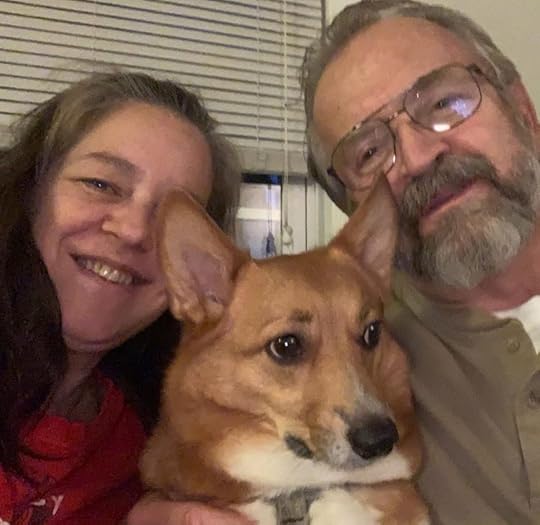 The freedom to spend time with your loved ones never gets old.
The freedom to spend time with your loved ones never gets old.TAKEAWAY #9: Freedom is the ultimate prize, the number one answer we hear from Solo Build It! members when we ask them what they enjoy most about being a solopreneur.
It’s not just about the money; it’s about what the money and the business model make possible. Cheryl’s journey is a perfect example of how building a business with a system like Solo Build It! isn’t just a financial goal—it’s a lifestyle goal.
I think having a strong “Why” is the most important thing. Creating a business to make money is usually the top reason and the second is around having more time. And both are great and can happen!
However, making money and having time is not enough of a why. I read once that many who start an online business don’t actually end up with a business but rather, they end up with a job they do from home.
I still believe that passion is the most important thing. I’ll requote what I quoted 10 years ago in our last interview:
“The secret to success in life is to make your vocation your vacation.”
— Mark Twain
This is true for business as well. Choose a niche (topic) that you’re excited about, that you can picture yourself talking and writing about for years. That’s when a business is a business and not just a full-time job you do from home!
TAKEAWAY #10: Thanks for this nugget of wisdom, Cheryl! After 15 years, her advice isn’t about a specific marketing tactic or a new tech tool. It’s about the engine that drives everything else: your “why.”
She continues by saying that “making money and having time is not enough of a why.” Without a deeper passion for your niche, your business can quickly become just another “job you do from home.”
Not having a strong “why” and picking the wrong topic are two of the main reasons why bloggers quit. Don’t let it happen to you!
This is why the first five chapters (we call them DAYs) of the Solo Build It! Action Guide are all about discovering your best niche, focusing on the intersection of your passion, your knowledge, and what people are searching for.
Cheryl’s long-term success comes from the fact that she chose a topic she genuinely loves and can see herself “writing about for years.”
That passion is the fuel that gets you through the tough times and turns a business into a vocation. It’s the true foundation for building something that lasts.
To sum it up, I’ve put together the highlights and key lessons from Cheryl’s SBI! success story:
How Do You Create a Business That Serves Your Life?Listen, Then Create: Cheryl’s business grew because she listened. From digital products to her membership, every new income stream was a direct response to what her audience asked for. Solve their problems, and they will tell you how to monetize.Design Your Life, Then Build Your Business Around It: She takes a week off every month and works one day a week in the summer. By treating her time as the most valuable asset, she created a business that fits her life, not a life consumed by her business.Scale Your Income in Stages: She didn’t start with a membership. She began with ads, then added digital products, and finally launched her recurring revenue stream. This gradual, user-driven approach is a sustainable way to grow your income over time.Let Passion Be Your Foundation: Her final piece of advice is so important. The reason she has thrived for 15+ years is her genuine passion for her niche. That passion is the fuel for longevity, turning a potential “job” into a fulfilling vocation.Cheryl’s story proves that it’s possible to build a business that is both highly profitable and perfectly aligned with the life you want to live. She is just one of thousands of “everyday people” who have built successful, life-changing businesses with Solo Build It!.
Want to learn from more of them?
Sign up for our free 10 Real Life Success Lessons email series. Each day, you’ll meet another successful SBIer and discover a unique, actionable lesson to help you on your own online business journey.
Author information Margit Streifeneder
Margit StreifenederMargit Streifeneder is the Marketing Co-Director at SiteSell. She works with a small but mighty team to spread the word about Solo Build It!, via helpful content, informative emails and eye-catching ads. She's passionate about helping solopreneurs achieve success, and enjoys interviewing SBI! members about their achievements. Besides growing her own online business, she loves exploring new places, hiking, dancing and spoiling her four cats.
|The post Six Figures on Her Terms: A Lifestyle Business Success Story appeared first on SiteSell Blog - Proven Real-World Advice for Solopreneurs.
September 18, 2025
How to Choose the Perfect Domain Name for Your Online Business (Part #2 of 4)
You did it. You pushed past the doubt and landed on a niche you’re genuinely excited to explore. Take a moment to appreciate that — it’s a huge achievement and the true starting point of your business.
The next step is to give that brilliant idea a home online. And that starts with choosing your domain name.
This is often the moment things feel real. And with that feeling, the pressure to find the “perfect” name can bring that old perfectionism creeping back. Didn’t we just agree in the first article that it’s okay to “start messy”? How does that square with a decision that feels so permanent?
Here’s the secret: think of your domain name not as a forever tattoo, but as the foundation stone for your business experiment. It’s the first tangible step that makes your business real, and you can lay it with confidence.
Real-World Example: Choosing a Domain Name for a Gardening NicheTo see how this works in practice, let’s follow along with a (fictitious) fellow beginner, “Gardener Grace.” She just settled on her passion for sustainable gardening for city dwellers. Now she’s ready to find a home for her new idea.
A Quick Note About the Solo Build It! Action GuideAs you follow along with Grace, remember that these articles are designed to give you a friendly boost to get you over those first few hurdles of settling on a niche with confidence.
As an SBI! member, you’d have access to the Action Guide as your complete roadmap. It goes much deeper into brainstorming, keyword research and validating your niche before choosing a domain name. We recommend you follow that process when you’re ready.
Our goal here is to help you build the momentum and mindset to tackle those steps without getting stuck. This series is your companion, not a replacement for the powerful tools and in-depth strategy waiting for you in the Action Guide.
A domain name is your business’s brand identity. The easier it is to find and remember, the better.What Makes a Domain Name “Great,” Anyway?save pin for later
Before Grace brainstorms, she needs a clear target. A great domain name isn’t just a web address, it’s a strategic asset for your business. The best domain names are:
Easy to Remember and Spell – If you have to explain it twice, it’s too complicated. Avoid hyphens and numbers — people forget them.
Brandable – The best names should sound like a real brand, not a generic description. Compare PawsitivePath.com to BestDogTrainingOnline.com. Which one feels more memorable?
Relevant (but not restrictive) – Your domain name should hint at what you do while leaving room to grow. Grace’s idea of BalconyHerbs.com works — but what if she expands into rooftop gardening? That name could feel limiting. A name that captures the spirit of her niche gives her more room to grow.
Voice Search Friendly – Aim to use short (ideally 6–14 characters) and clear names that are relatively easy to pronounce for people, and for AI to understand when voice search is used.
A .com Domain Extension – For a global audience, .com is still the most recognized and trusted extension. However, if your business will primarily serve customers in the United Kingdom, for example, a country-specific domain name ending in .co.uk is an excellent, trusted alternative.
What to avoid – Trademarked names, confusing spellings and slang that may not age well.
Three Paths to Finding Your Perfect Domain NameIf you’re stuck, most great domain names follow one of these three paths:
PathExampleBest ForWatch Out ForBrandableSproutjoy.comLong-term brandingMay lack instant clarityClear and DirectCityGardeningGuide.comBeginners, SEO clarityLess uniqueKeyword-RichSustainableUrbanGardening.comSearch intent matchGeneric, hard to brandGrace’s Take on Each PathBrandable – She could register a unique name like VerdantDwelling.com or Sproutjoy.com. Each feels flexible (for expanding on) and future-proof.Clear and Direct – She could register a name like CityGardeningGuide.com which is instantly understandable.Keyword-Rich (Use with caution!) – The SustainableUrbanGardening.com name tells search engines exactly what it’s about but feels generic and harder to remember. For her long-term vision, a brandable name would be stronger.Your 5-Step Action Plan to Find and Register Your Domain NameLet’s walk through the exact process Gardener Grace followed.
Step 1: Brainstorm “Word Banks”Grace creates lists of words around her niche
Core Niche Words – urban, city, garden, balcony, patio, plants, green, rooftop
Target Audience – beginner, renter, dweller, small space
Benefits/Outcomes – thriving, simple, peaceful, fresh, harvest, easy
Descriptive Adjectives – happy, vertical, smart, modern, little
Action Verbs – grow, nurture, sprout, design, thrive
* To create your own word banks, use a keyword research tool (like SBI!s Brainstorm It!, Ubersuggest or Ahrefs) to check actual search demand.
Step 2: Create Combinations With Proven PatternsNow for the fun part! Grace mixes and matches words to spark creative combinations.
Step 3: Check AvailabilityGrace then runs her favorites through a domain name checker (like Namechk or Knowem).
UrbanGarden.com and CityGardener.com are already taken. That’s perfectly normal! She isn’t discouraged because she has a long list of other creative options to check.
Step 4: Run the Final ChecksGrace narrows it down to three domains: CitySprouts.com, TheGreenRenter.com, PatioHarvest.com. Then she asks:
Is it easy to spell?Is it free of trademarks?Does it work across cultures?Are matching social media handles available?Step 5: Register It!The winner is clear. Grace registers CitySprouts.com with confidence. She’s done the work, trusted the process, and now owns her own first piece of digital real estate.
She’s laid the foundation stone. Now the real fun of building can begin!
Ready to Make It Official?You’ve done the work. You’ve brainstormed, tested and evaluated your options. Just like Gardener Grace, you’ve found a domain name that feels right and passes the final checks. That’s a huge milestone!
The next step is simple but exciting: officially register your domain. You can do this with trusted providers or within Solo Build It! (included).
Want step-by-step help? DAY 5 of the Action Guide walks you through the full process with detailed instructions.
Make it happen.
FAQs About Choosing a Domain NameQ: What if the domain name I want is already taken?
A: Don’t panic. Try variations (adding “the,” plural forms or brandable twists). You can also check if the domain name is for sale. But avoid awkward spellings. Clarity is more important.
Q: Should I use .net, .org, or .co if .com is taken?
A .com is still the gold standard. If your audience is specific (e.g., nonprofit = .org, UK = .co.uk, tech startup = .io), those can work. Just make sure it fits your brand
Q: Can I change my domain name later?
A: Yes, but it’s best to avoid it. Changing domain names can affect branding, links and search rankings. Choose wisely now and you’ll save yourself headaches later.
What’s Next?This was Part 2 of our 4-part series on choosing your niche and turning it into an online business.
Part 1: How to Test Business Niche Ideas… Until One FitsPart 2: Choose the Perfect Domain Name for Your Online Business (You’re here!)Coming Soon
Part 3: Building Your First Website Around Your Domain NamePart 4: Laying the Foundations for Long-Term GrowthStay tuned for the next article, where w’ll walk through how to build your website around your new domain name.
Want the next article delivered straight to your inbox?
Subscribe For FreeEmail Address By subscribing, I consent to receiving emails from Solo Build It!(function($) {window.fnames = new Array(); window.ftypes = new Array();fnames[0]='EMAIL';ftypes[0]='email';fnames[1]='FNAME';ftypes[1]='text';fnames[2]='LNAME';ftypes[2]='text';}(jQuery));var $mcj = jQuery.noConflict(true);
Author information Carol Leather
Carol LeatherCarol Leather is head of content at SiteSell. She started her first successful online business, www.needlework-tips-and-techniques.com, with Solo Build It! in 2006 and it's still going strong. She loves photographing and drawing wildlife. She shares her walks in the English countryside on her new site www.naturewalkswithcarol.com. When she is not busy with all the above, she works on her two art sites! All using Solo Build It!, of course.
|The post appeared first on SiteSell Blog - Proven Real-World Advice for Solopreneurs.
September 11, 2025
From Sheds to Sales: A 20-Year Digital Product Success Story
So had I not found Solo Build It! 20 years ago and built my website, which is a labor of love, I don’t think we’d be where we are now financially! John Shank, www.shedking.net
What does it take to turn a lifelong passion for building into a life-changing online business?
For John Shank, the journey started not online, but after a 22-year career in grocery store management that left him yearning to make a living doing what he truly loved: working with wood.
He became a professional shed builder, learning every detail of the craft through grueling physical labor. But he dreamed of using his hard-won knowledge in a better way.
His first attempt at a website was on a cheaper platform—as he says, “I was dead broke at the time!” After two years with little to show for it, he knew he needed a different path.
Convinced by the Solo Build It! process, John made a decision that speaks volumes about his commitment: he took out a personal loan, using $300 of it to finally buy his one-year SBI! membership.
That was over 20 years ago. Today, John calls it “the best business decision I have ever made,” with a thriving online business that has sold over 29,000 shed plans.
In our interview, John shares the remarkable story of his two-decade journey—the “eureka” moments, the “roller coaster” of Google updates, and the lessons learned that have kept his business successful and relevant for many years.
1. John, it’s been a decade since our 2015 interview , and more than 20 years since you started shedking.net. Can you share a few highlights from this journey, the good, the bad and the ugly?My journey, since I started using Solo Build It! (or Site Build It!, as it was called back then) for building shedking.net, has been one that I am extremely happy with, and one that I am eternally grateful for.
To this day, I can’t wait to get out of bed, which is normally around 5am, make a cup of coffee, turn on the computer, and see what my sales have been for the previous day. It’s an addiction.
I’ve pretty much been following this routine just about every day of the week since I started developing my own shed plans for sale. The very first time I sold a shed plan, way back in 2010, it was like eureka!
I couldn’t believe someone actually bought a shed plan from me. I was scared and excited at the same time.
I just knew that person would email me right away and ask me why I sold them such a piece of crap. I waited and waited, but I never got that nasty email. Thank God!
 One of the very first pictures John got from his early (and happy) shed plan buyers.
One of the very first pictures John got from his early (and happy) shed plan buyers.I knew from that day forward, this was some type of dream that I was finally able to realize. My dream of selling something online. My shed plans.
I’ve tried so many money-making schemes in my life that failed, but SBI! was not a scheme. SBI! was the one thing in my online journey that actually helped me to generate an income.
 save pin for later
save pin for later 
What a side hustle it’s been! A very profitable side hustle. I’ve since sold upwards of 29,000 shed plans.
Before I had my shed plans for sale, my income from my site was via Google Adsense. I did ok with the earnings from AdSense; it was enough at the time to pay for my monthly Solo Build It! subscription.
As for the bad and the ugly, my online journey with SBI! has not been all wine and roses. I suffered many setbacks with Google’s algorithm changes over the years. It’s been a roller coaster ride to say the least. I was never really devastated to the point that I felt like I had to give up.
So in that sense I consider myself lucky enough to still be in the online game, generating a fairly decent income with my site.
I’ve had major keywords in my niche go from being in the top 5 at Google, to dropping all the way into pages 3 and 4, with no recovery. Fortunately for me, though, I’ve come to realize that the majority of my traffic comes from long-tail keywords from T3 and T4 pages.
Today, I have around 55 shed plans (digital downloads) that I sell, ranging anywhere from $6 to $29. So for me, having digital products to sell has been a blessing.
I’ve been blessed first off to have found SBI! all those 20 some years ago, and blessed to have had the ability to learn all the software and programs that have allowed me to make and sell those shed plans online.
TAKEAWAY #1: 29,000 shed plans sold! John’s journey demonstrates the long-term potential of an online business. What I love most is his honesty about the “good, the bad, and the ugly.”His “eureka” moment of the first sale—feeling both scared and excited—is something every new entrepreneur can relate to. It’s that turning point where your idea becomes a real, income-generating business.
He started with AdSense earning just enough to cover his subscription, then transitioned to selling his own digital products, which created a “very profitable side hustle.”
This is a classic monetization strategy we teach at Solo Build It!. Creating and selling your own products, based on your unique knowledge, has a much higher income potential than ad networks like AdSense.
John’s story also provides a dose of reality. The journey isn’t a straight line; it’s a “roller coaster.” But by focusing on a proven process and not a “scheme,” he built a business that could withstand the ups and downs and provide a life-changing income.
A note about “long tail keywords from T3 and T4 pages”… if you’re wondering what John’s talking about, we’ll cover this at the end of the interview. So, keep reading!
2. Traffic from Google is still, by far, your number one traffic source, and seems undisturbed by recent algorithm changes, like the Helpful Content Update. What’s your “secret”? Has your content strategy changed over the years?Several years back I started using a service called RankIQ. It was recommended by fellow SBIer Gerhild Fulson from JustLikeOma.com.
I started using it in conjunction with SBI!’s keyword brainstorming tool and page builder. It helped me to zero in on pages with good demand and low supply numbers, while adding in other terms that Google wanted to see in the content that was written about those topics.
Out of the 15 to 20 pages I wrote based on RankIQ suggestions, I would say 80% of them ranked in the top 5 search engine results for the keywords I targeted. Some pages took two to three months to rank, others were somewhat quicker like one month.
I also used RankIQ along with Tai (SBI!’s AI assistant) to update some of my older outdated pages.
This work has already paid off. My Google traffic has gone up significantly this year.
 Google Analytics stats for shedking.net from January 2022 to August 2025: While showing some ups and downs, Google organic remained John’s highest traffic driver.
Google Analytics stats for shedking.net from January 2022 to August 2025: While showing some ups and downs, Google organic remained John’s highest traffic driver.The second thing I am doing is spending more time on Facebook and Instagram. I participate in Facebook groups and look for individual posts that are closely related to anything having to do with building sheds, shed houses, chicken coops, etc.
My thinking behind this approach is that people visiting these types of groups may be interested in purchasing one of my shed plans.
I don’t post anything blatantly obvious like “Hey all you chicken lovers, I’ve got some chicken coop plans for sale here at shedking.net. Come on over and buy a plan from me!”
My interaction is more of being an innocent bystander who can help people in these groups with advice I’ve gained from being a professional shed builder and home remodeler.
Sometimes I add a picture from the hundreds of photos I’ve taken over the years of a related construction issue, and the picture has shedking.net on it for branding.
Then I will also include a link to the relevant information I have on my site that might help them understand the solution to their problems in more detail.
Some of those visitors may buy a shed plan from me!
I also do this on Instagram, but it doesn’t seem to be as easy on that platform.
For Pinterest — I have lots and lots of pins there as well. Those are more geared towards selling my plans with pictures that show the benefits of building one of my sheds, and those link directly to that plan’s sales page.
I use Tai Freestyle quite a bit for writing titles and descriptions for all my social media postings.
In the past I’ve also run ads on Facebook, but without much success. At the time I was doing the ads, I was spending $5 to $10 a day without much return. My problem was not spending enough time learning the best ways to optimize my ads.
TAKEAWAY #2: There’s no single “secret” to John’s stable traffic; it’s a smart, two-part strategy of content optimization and community engagement.First, for his content, he combines an external tool (RankIQ) with his core Solo Build It! process. He isn’t replacing what works; he’s enhancing it. He uses the tools to find low-competition topics and then builds his pages the SBI! way, a process that has clearly paid off with high rankings.
This is a great lesson for any long-time business owner: stay open to new tools that can complement your proven system.
Second, his approach to social media is a masterclass in modern marketing. He’s not on Facebook to broadcast ads; he’s there to help. By participating in groups and offering genuine advice as a professional, he builds trust and authority. The links he shares aren’t spam; they’re helpful resources.
This value-first approach is the essence of PREselling, a core concept we’ve taught at Solo Build It! for decades. You build a relationship and establish credibility before ever asking for a sale.
 Happy chickens in John’s DIY chicken coop!3. You’ve started using our AI assistant, Tai. As a long-time SBIer who has built a successful site “the old-school way,” how are you integrating a modern tool like AI into your workflow? What specific tasks do you find it most helpful for?
Happy chickens in John’s DIY chicken coop!3. You’ve started using our AI assistant, Tai. As a long-time SBIer who has built a successful site “the old-school way,” how are you integrating a modern tool like AI into your workflow? What specific tasks do you find it most helpful for?As I mentioned above, I like to use Tai Freestyle for helping me come up with titles and product descriptions for my Facebook, Pinterest, and Instagram posts. I’m constantly amazed how intuitive Tai is and how easy it is to use.
There are times when it almost feels like Tai has the ability to read my mind when I can’t seem to get the prompt input just the way I want it.
I mentioned previously that I used RankIQ to help me write new content pages. RankIQ generates a list of words that Google likes to see in the content associated with the keyword you intend to write about.
Having copied these words off of RankIQ, I’ll then go over and open up Tai, specifically Prompt Build It. I’ll go through each of the steps following the specific guidelines for each step.
When I get to step 6 (Pertinent Connections), I will enter the primary and secondary keywords, then down at the bottom for the sentiments section, I will paste in all the words I previously copied from RankIQ that are the words Google likes to see in the content.
Once Tai has generated the content for me, I will then copy this content, then go back to RankIQ and open up the content analyzer. RankIQ then spits out some figures letting you know if the word count is enough, and also whether or not you’ve covered enough of the needed words that Google considers worthy of being in your webpage/blog.
RankIQ also gives you guidelines on writing good headlines based on headlines written by the websites that rank in the top 10 for the keyword you’re targeting. I generally take advantage of that option as well for my webpage/blog.
Once I have edited the content in RankIQ to get what they consider to be good enough to post, I’ll copy that content, then go over to SBI! and create a new web page about that topic.
I edit the copy some more, adding headings and sub-headings, and appropriate images that I have personally made over the years with my shed building information and shed plans. I consider myself to be very fortunate here as I am able to use all my own original images.
With this new page pretty much completed, I will then run it through SBI!’s page analyzer and make adjustments accordingly. Then I’ll go ahead and publish the page.
TAKEAWAY #3: It made me chuckle when I read that John sometimes feels as if “Tai has the ability to read my mind” — can you relate when working with Tai or another AI chatbot? That intuitive ease-of-use is one of Tai’s strengths. But what’s really interesting is how John harnesses AI in a much more structured way for his core content creation.He doesn’t just push a button; he has a repeatable, multi-step system:
Research -> AI Draft -> Refine -> Humanize.
He starts with research (using RankIQ) to identify what Google wants to see in a page about his chosen topic.He feeds that research into Tai’s Prompt Build It! to create a strong initial draft. This is where his process gets really clever. In Step 6, “Pertinent Connections,” Tai asks for keywords and sentiments—related concepts that help the AI stay on target.John takes his entire list of words from RankIQ and pastes them into the sentiments field. This “bathes” the AI in the precise language Google wants to see, ensuring the first draft is super relevant.He then refines that draft using RankIQ again to ensure it meets quality metrics.Finally, and most importantly, he humanizes it in SBI!’s BlockBuilder by adding his own voice, structure, and unique, original images.This is a brilliant hybrid approach. The most crucial step is that final one. It’s a perfect demonstration of a core principle highlighted in our Tai Guide: “Just. Add. You!”.
AI provides the foundation, but John’s personal expertise and unique assets are what make the content truly valuable and trustworthy.
4. What do you see as the biggest benefit of using a tool like Tai for your business? On the flip side, what potential pitfalls should solopreneurs be mindful of when using AI for content?I’ve found the older I get, the harder it is for me to write content. That’s where I really love Tai. I would have to say that I use the Freestyle option more than the Prompt Build It option.
I’ve used Tai Freestyle extensively and have given it all sorts of queries ranging from webpage info such as good meta descriptions to creating a business plan for advertising the benefits of using virtual or augmented reality for selling my shed plans.
Tai is just simply amazing to me in how it helps me jog my brain to figure out the best avenues to take on whatever I decide to use it for.
I find that the biggest pitfall to using Tai for content is that you have to make sure that whatever gets generated is absolutely factual. It’s very easy to just skim over the generated content without actually making sure that everything is 100% accurate.
I found this to be the case when I first started using Tai. I was so excited when it first came out that I didn’t check the content it created thoroughly. Now, I go over everything as best as I can, adding my own voice and images, and making sure everything is legitimate.
TAKEAWAY #4: Another excellent lesson from John: He doesn’t see Tai’s biggest benefit as just writing content faster; he sees it as a tool to “jog my brain.”For anyone who has ever felt stuck or found it harder to come up with fresh ideas over time, this is a key insight. He uses AI as a creative partner to overcome mental blocks and explore new avenues—even complex ones like using virtual reality for his business!
And his advice on the flip side is just as important: the biggest pitfall is complacency.
John admits that when he first started using Tai, he was so “blown away by its capability” that he didn’t verify the AI-generated content as thoroughly as he should have. It’s easy to assume that because the text sounds authoritative, it must be accurate.
This is why the final step is non-negotiable: you must go over everything, fact-check it, and infuse it with your own voice and experience. It’s another reminder of our core principle: Just. Add. You! Use AI to spark creativity, but always be the final, human expert.
5. In 2015, part of your advice for our readers was to learn all about and use social media. Would you still give this advice today? Has your own usage of social media changed over the years?I use social media almost every day. As I mentioned above, I make a lot of comments in Facebook Groups related to my niche, trying to be as helpful as possible rather than trying to sell to them.
I can definitely see a correlation to my Facebook posts and increased sales of my shed plans. It seems the more I contribute, the more I sell.
I also try to post as much as I can on Pinterest and I get anywhere from 5 to 10 Pinterest likes a day on my posts.
 An example of John’s Pinterest posts, advertising one of his barn shed plans.
An example of John’s Pinterest posts, advertising one of his barn shed plans.I’m not good at checking in on Google Analytics to determine what’s working the best for me. It’s something I need to delve into more. However, I’d rather spend my time on generating more sales by commenting in Facebook Groups rather than obsessing over my stats.
TAKEAWAY #5: A decade later, is John’s advice on social media still a firm “yes”? Absolutely. But his approach is what holds the most valuable lesson.He’s not just posting content; he’s actively participating in niche communities, specifically Facebook Groups. He acts as a “helpful, innocent bystander,” sharing his professional expertise and building trust long before he ever suggests a sale.
John’s results prove it works: “the more I contribute, the more I sell.”
What I also find insightful is his admission that he doesn’t obsess over analytics. He’d rather spend his limited time on the very activity he knows is driving sales.
This is a practical lesson for every solopreneur: focus on the actions that generate results.
6. Many successful online businesses rely heavily on their email list. What role does email marketing, including your newsletter ‘Shed ‘N Sight,’ play in your overall business strategy?I could definitely do more with my newsletter. I’m sad to say that I’ve probably sent out fewer than 20 newsletters in the last 20 years! I do have an account with Kit, formerly Convert Kit. As it stands right now, I have around 2000 subscribers at Kit, and about 500 subscribers on my SBI! mailout list.
My original payment processor for selling my shed plans was E-junkie and through them, or so they claimed, I had over 28,000 subscribers. I don’t feel this number was correct. I think this was simply the number of shed plans I had sold over the years that I was with E-junkie.
I’ve since switched over to Shopify as my payment processor and those 2000 subscribers at Kit have come from my Shopify buyers.
My niche of shed building is to me kind of a ‘One and Done’ deal where they came to my site for a plan to build their shed, and that’s all they’re interested in.
TAKEAWAY #6: This answer took me by surprise. I expected email marketing to play a bigger role in John’s success, yet he’s sent fewer than 20 newsletters in 20 years!His reasoning—that shed building is a “One and Done deal”—is understandable on the surface. But to me it highlights an untapped opportunity.
Think about all the visitors who land on his site who aren’t ready to buy a shed plan that day. They’re interested, but they’re still in the research phase. Without a way to capture their information, those potential customers are lost, likely forever.
This is where an email list becomes so valuable, even in a “one-off” niche. Imagine if John offered a simple freebie, like a checklist that solves some common problem in shed building, in exchange for an email address.
He could then send a series of helpful tips. When those visitors are finally ready to build, who will be top of mind? The ShedKing, of course!
Even successful businesses have room for growth. So my advice to John would be to give email marketing a try. We have a whole section about it in our knowledge base for SBIers.
7. In our original interview, you spoke about building an additional income stream for retirement. Looking back, did you achieve that goal? Could you also share how your site earns income today and how that has grown or changed since 2015?Yes, I have achieved that goal. I have consistently maintained that goal for the last 10 years and I feel pretty comfortable where I am financially right at this moment in time. I have however tried to not be too dependent on the earnings from my site.
My wife and I have been able to sock money away into savings and retirement accounts, and we have our house paid off, and also own a rental that is fully paid off.
Was this due to my income from my SBI! site? I can definitely equate the dollar amounts of allowing us to become debt free to the money I’ve generated with my website.
So had I not found Solo Build It! 20 years ago and built my website, which is a labor of love, I don’t think we’d be where we are now financially!
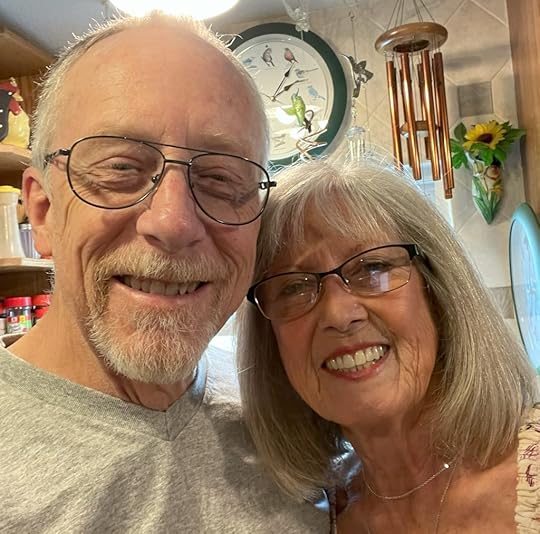 John and his wife SarahTAKEAWAY #7: What I find most amazing—and reassuring for any solopreneur—is the longevity of John’s success.
John and his wife SarahTAKEAWAY #7: What I find most amazing—and reassuring for any solopreneur—is the longevity of John’s success.His online business has been a reliable income source for over two decades, weathering everything from the Panda and Penguin algorithm updates to the recent HCU and global economic crises. This isn’t just a “side hustle”; it’s a resilient asset.
And what does that kind of long-term stability create? The tangible, life-changing results John talked about: paying off a house, owning a debt-free rental property, and building a secure retirement.
His own words say it best:
“So had I not found Solo Build It! 20 years ago and built my website, which is a labor of love, I don’t think we’d be where we are now financially!”
This is the true value of a sustainable online business. It’s not just about building a website; it’s about building a better, more secure future, year after year.
8. After all these years, what do you still find most rewarding about being an online business owner?For me it’s being able to make money from my knowledge while helping customers out at the same time by providing a solution to their problem(s).
I feel like this is the key to someone just starting out with an online presence. Take what you know or feel passionate about and share it. Use your website to promote your knowledge and sell your knowledge either by writing an ebook, or developing a course.
One to one is not the key, but rather one to many. Use the web to reach a global audience to sell your knowledge.
I feel fortunate to have a website—which I’ve developed with the help of SBI!—that has given me fairly consistent income almost every year since I started it in 2004.
 A $160,000 kitchen and whole house remodel John did last year. He surely knows a thing or two about building beautiful things out of wood.TAKEAWAY #8: John’s answer reflects a common source of motivation for solopreneurs: the joy of earning income from their knowledge, while at the same time helping people solve a problem.
A $160,000 kitchen and whole house remodel John did last year. He surely knows a thing or two about building beautiful things out of wood.TAKEAWAY #8: John’s answer reflects a common source of motivation for solopreneurs: the joy of earning income from their knowledge, while at the same time helping people solve a problem.He then offers this as advice, and it’s a golden nugget for anyone starting out:
“One to one is not the key, but rather one to many.”
This is the fundamental shift an online business offers. Instead of helping one client at a time, your website allows you to share your knowledge with thousands—or in John’s case, tens of thousands—of people around the world, 24/7.
This principle is the very foundation of the Solo Build It! process. We help you take your unique knowledge—whether it’s about sheds, baking, or travel—and turn it into a scalable business that helps a global audience.
It’s this combination of purpose (helping) and profit (earning) that makes this journey so rewarding.
 A family picture from Christmas 2024.9. Finally, what is your most important piece of advice for long-term solopreneurs who are working to keep their mature website successful and relevant year after year?
A family picture from Christmas 2024.9. Finally, what is your most important piece of advice for long-term solopreneurs who are working to keep their mature website successful and relevant year after year?One of the things that I didn’t mention earlier was that I’ve gone back and revamped older pages on my site. I looked for pages that were not as comprehensive as they should have been and added more valuable and up to date content.
I think this too has helped to increase my rankings, especially for long-tail keywords.
So, this would be my main advice for people with a mature website:
Regularly review your pages or blog posts, especially the ones you wrote long ago, and improve them with useful, up-to-date content.
I plan on doing more of this in the near future myself. I also recently read something that Ken Evoy had said in the SBI! forums: his advice was to add more T4 pages on our websites. That’s awesome advice for all of us and I plan on doing more of that as well.
TAKEAWAY #9: John’s final piece of advice is pure gold for anyone with a mature website. The key to long-term relevance isn’t just creating new content; it’s continuous improvement.His core strategy is simple: go back and revamp your older pages. He actively looks for content that isn’t as comprehensive as it could be and enriches it with more valuable, up-to-date information. This not only keeps his site relevant for visitors but, as he notes, also helps his rankings for long-tail keywords.
He then reinforces his strategy with high-level advice he gets from being part of the SBI! community. He specifically mentions a recent tip from Ken Evoy, our founder and CEO, in the SBI! forums: add more T4 pages.
For those wondering, Tier 4 (T4) pages are a key part of a well-structured website, which is beneficial for both human visitors and search engines.
Think of your site like this:
Tier 1 is your home page, representing your site concept.
Tier 2 pages are the main categories of your site concept.
Tier 3 pages cover specific topics within those categories.
Tier 4 pages dive into even greater detail on a single idea mentioned in a Tier 3 page. They often answer very specific, long-tail questions (like those used in voice search) and are the in-depth content that builds authority and attracts exactly the visitors you want to get to your site.
What Are the Key Lessons For Long-Term Online Success?John’s 20-year journey, from taking out a loan to building a legacy, is packed with advice that applies to any niche, not only shed-building.
I’ve distilled his answers into these four core principles (feel free to copy and paste them on a sticky note!):
Productize Your Knowledge: John’s business transformed when he shifted from AdSense to selling his own digital products—his shed plans. Turning your expertise into a scalable product is the foundation of a sustainable online income.Build Trust Before You Sell: He doesn’t advertise on social media; he helps. By offering genuine advice in communities, he builds authority and trust, which naturally leads to sales. This is the essence of PREselling, one of Solo Build It!’s core teachings.Continuously Improve Your Assets: A mature website is not a set-in-stone document. John’s strategy of consistently revamping and improving his older content is crucial for maintaining relevance and rankings year after year.Embrace the “Labor of Love”: Through all the “roller coaster” moments, John’s genuine passion for his work and the business he built was the fuel that kept him going. Long-term success requires both a smart strategy and a deep commitment.
Feeling inspired by John’s story?
He is one of the thousands of “everyday people” who’ve built successful, life-changing businesses with Solo Build It!.
For even more inspiration, sign up for our free 10 Real Life Success Lessons email series. Each day, you’ll meet another successful SBIer and discover a unique, actionable lesson to help you on your own online business journey.
Author information Margit Streifeneder
Margit StreifenederMargit Streifeneder is the Marketing Co-Director at SiteSell. She works with a small but mighty team to spread the word about Solo Build It!, via helpful content, informative emails and eye-catching ads. She's passionate about helping solopreneurs achieve success, and enjoys interviewing SBI! members about their achievements. Besides growing her own online business, she loves exploring new places, hiking, dancing and spoiling her four cats.
|The post From Sheds to Sales: A 20-Year Digital Product Success Story appeared first on SiteSell Blog - Proven Real-World Advice for Solopreneurs.
September 4, 2025
How to Test Business Niche Ideas… Until One Fits (Part #1 of 4)
Struggling to choose an online business niche? You likely have lots of ideas, interests and passions, but making the right niche decision feels overwhelming.
Many folks believe they need to find the perfect niche right from the start, one that will define their business forever. That pressure often leads to “analysis paralysis” and keeps them from ever taking the first step.
The reality is, successful solopreneurs don’t wait for the “perfect” niche to magically appear. Choosing an online business niche is less about locking yourself in forever and more about starting with a solid direction, testing it and learning as you go.
Instead of aiming for perfection, focus on using a practical process that allows you to refine and adapt. Approaching your decision this way leads to clarity, confidence and long-term success.
Your New Motto: Start Messy, Find ClarityThink of your first attempts at anything – your niche, a webpage, your services, etc. like trying on an outfit. You don’t expect the first thing you grab to be the one. You try things on, see what fits and discard what doesn’t. Your business ideas need the same freedom.
Instead of seeing your initial efforts as “wrong,” view them as necessary drafts.
To put this into practice:
Start where the energy is. You don’t have to perfectly analyze ten different niche ideas at once. Which potential topic feels most exciting to you today? For example, is it the one based on your passion for sustainable gardening?
Forget about a business plan. Just spend ten minutes on this one small task:Jot down five potential article titles for that sustainable gardening idea. That’s it. That simple, low-pressure act will tell you more about your energy for the topic than days of circular thinking.
Give yourself permission to discard. Just because you have an idea on paper doesn’t make it the right topic for starting a business around. It’s not only okay, but essential to throw away clunky beginnings or confusing concepts. It’s always easier to revise something that exists than to create something from a blank screen.
What Does a “Draft Thought” For a Niche Look Like?
Before you even worry about a business plan or content strategy, a “draft thought” is just the simple kernel of an idea. It’s permission to be curious.
A draft thought might sound like:
“I wonder if there’s a website for people learning to bake sourdough for the first time?”“What if I taught something about minimalist travel for families with young kids?”“Could I possibly help freelancers who struggle to manage their money properly?”These aren’t commitments. They’re questions or sparks. The goal is to collect a few of these without judging them. Once you have a couple messy ideas, you can start to see what they’re really made of.
A Framework to Test Your Drafts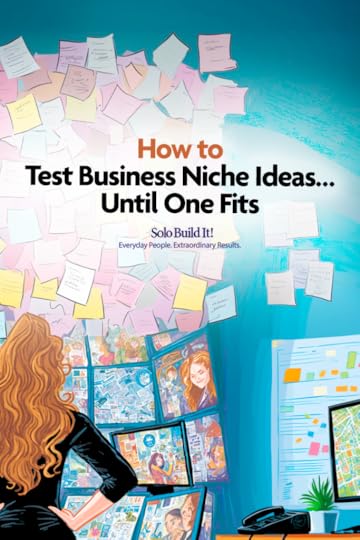 save pin for later
save pin for later 
So how do you know which of your draft thoughts has the most potential?
This is where some fantastic advice from a long-time Solo Build It! customer named Richard comes in. He provides a common sense framework for trying your niche ideas on for size.
Think of these four niche types as four different outfits to try on. Which one feels most like you right now?
The Passion-Based Niche (Follow the Fun!)This is the topic you could talk about for hours without getting bored.
Ask yourself: Do you already read or watch content about this in your free time? Do you think you will still be interested in it five years from now?The Expertise-Based Niche (Share What You Know!)
This is where you have formal training or hard-won experience. People might already ask you for help with this.
Ask yourself: Can you create tutorials on this topic? Do you have access to stories or data others don’t?The Problem-Based Niche (Solve the Pain!)
This is about finding a recurring problem that people are struggling with and offering a helpful solution.
Ask yourself: Have you personally solved a problem others have? Are online communities asking questions you could answer?The Market-Based Niche (Spot the Opportunity!)
This is a pure business play, born from seeing a need in the market.
Ask yourself: Do you see people actively searching for this? Have you seen others successfully monetize it? Is there an underserved audience here?Find the “Sweet Spot”
Now, you might be looking at those four niche types and thinking, “my idea doesn’t fit perfectly into just one box.”
That’s okay – in fact it’s fantastic! The most powerful niche ideas often live where these categories overlap. That overlap is the sweet spot.
Let’s take that “sourdough for beginners” idea:
It could be Passion-Based (you love baking).It could also be Problem-Based (beginners always struggle with their starters).If you’ve figured out a simple method, it becomes Expertise-Based, too.When you find a draft thought that checks two or even three of these boxes, that’s a huge green light. It means the idea has energy, serves a real need and you could be the perfect person to build it. You don’t need all four, but finding a powerful combination like Passion + Problem is a great sign you’re onto something special.
Step-by-Step: How to Test a Draft NicheChoosing a niche doesn’t have to feel like risking your future. Think of it as running a simple experiment. Here’s a step-by-step process you can try right away:
Choose one idea that excites you todayBrainstorm 5 – 10 potential article titles (use an AI tool like Tai to help)Search online communities for validationLook for keyword demand (Google Trends, AnswerThePublic, Pinterest Trends, SBI!’s Brainstorm It!)Create a small test piece of contentEvaluate and adjustThe point isn’t to “get it right” on the first try. It’s to move from theory into action, where real clarity lives.
Test Your Niche “Draft” Before You CommitThis is the key to moving forward with confidence. Instead of treating your choice as an irreversible decision, treat it as an experiment. You aren’t building the entire business yet. You are just testing the foundation.
By viewing your niche as a “draft,” you give yourself the freedom to research, experiment and even pivot without feeling like you’ve wasted time. You’re just gathering data!
So, what’s one “draft thought” for a niche you can try on for size today?
Ready to Test Your Draft Idea?You don’t need a perfect plan. You don’t need to “get it right” the first time. What you do need is the courage to start messy, jot down a few ideas and test them in the real world. That’s how clarity comes.
The good news? You don’t have to do this alone — or with no direction.
In the next article of this series, we’ll show you how to take your “draft thoughts” and put them through simple research steps using free tools plus advanced tools like SBI!’s Keyword Research Tool.
You’ll learn how to see which niche ideas have genuine search demand, where the opportunities lie and which niches might be worth building a business around.
Your messy start is the spark. The next step is turning that spark into focus — and that’s where the real magic begins!
Frequently Asked Questions About Choosing a NicheQ: How do I know if my niche idea is profitable?A: Profitability comes down to three things: audience demand, low-to-manageable competition, and your ability to offer unique value. Start by checking search demand with tools like SBI!’s Brainstorm It!, and see if people are already spending money in that space.
Q: What if I choose the wrong niche?A: There’s no such thing as “wrong.” Every attempt teaches you something about what resonates (and what doesn’t). Think of it as a draft. You can pivot or refine without starting from scratch.
Q: How long should I consider a niche before committing?A: Give yourself 30 – 60 days to research. Watch for signs of traction (search traffic, engagement, or shares). If you see growth, keep going. If not, revisit some of your other ideas.
Q: Can I combine two niche ideas?A: Absolutely. Some of the strongest niches live at the intersection of two passions or problems – for example, minimalist travel for families with young kids or sourdough baking for busy professionals.
Want the next article delivered straight to your inbox?
Subscribe For FreeEmail Address By subscribing, I consent to receiving emails from Solo Build It!(function($) {window.fnames = new Array(); window.ftypes = new Array();fnames[0]='EMAIL';ftypes[0]='email';fnames[1]='FNAME';ftypes[1]='text';fnames[2]='LNAME';ftypes[2]='text';}(jQuery));var $mcj = jQuery.noConflict(true);
Author information Carol Leather
Carol LeatherCarol Leather is head of content at SiteSell. She started her first successful online business, www.needlework-tips-and-techniques.com, with Solo Build It! in 2006 and it's still going strong. She loves photographing and drawing wildlife. She shares her walks in the English countryside on her new site www.naturewalkswithcarol.com. When she is not busy with all the above, she works on her two art sites! All using Solo Build It!, of course.
|The post How to Test Business Niche Ideas… Until One Fits (Part #1 of 4) appeared first on SiteSell Blog - Proven Real-World Advice for Solopreneurs.
June 19, 2025
The TALKING Method: A Dog Lover’s Guide to Website Monetization
Monetization. It’s a word that can feel intimidating, complex, maybe even a little… mercenary?
For many aspiring online entrepreneurs, the thought of “selling” can seem daunting. But what if monetization wasn’t just about products and profits, but about connection, trust, and genuinely helping people?
If You Could Talk to the Animals (and Your Audience)Cath Andrews, owner of the successful website Raising Happy Chickens, recently shared her unique perspective on monetization, drawing surprising parallels between earning income online and building a relationship with her rescue puppy, Molly.
Meet Molly, Cath Andrews’s rescue pup who inspired this article.
https://www.sitesell.com/blog/wp-content/uploads/2025/06/cathpupinmotion.mp4Forget complicated formulas and pushy sales tactics. Cath’s approach, playfully dubbed the “TALKING” method, focuses on the human element – understanding your audience deeply and communicating in a way that builds lasting trust.
This isn’t just about chickens or puppies (though they make great examples!). It’s about a fundamental shift in how we view monetization: moving from simply pushing products to genuinely serving our visitors.
Ready to learn how understanding your audience’s “squeaky toys” can unlock your website’s earning potential? Let’s dive in.
T is for Trust: The Foundation of All Website MonetizationBefore you even think about selling a product, an ebook, or a course, you need to lay the groundwork.
Just like Cath’s rescued puppy Molly wouldn’t trust her overnight, your website visitors won’t instantly trust you with their email addresses, let alone their credit card details.
In today’s world, rife with online scams, trust isn’t just nice to have – it’s non-negotiable.
People don’t buy from websites; they buy from people they trust.
How do you build this crucial trust?
Nurture Your Visitors: Like Cath caring for Molly, attending to her needs whether she wants to play, rest, or just watch, you need to meet your visitors where they are. Provide value consistently before asking for anything in return. Offer high-quality, helpful content that addresses their questions and concerns.The Critical “About” Page: This is often the first place potential customers look before deciding to buy or even subscribe. It’s your chance to show the human behind the website. But – and this is key – it’s not about you , it’s about them . Focus on Your Visitor: Don’t just list your credentials. Frame your story, experience, and knowledge in terms of how you can help them. Ask yourself, “What does all this about me have to do with my visitor?”Show, Don’t Just Tell: Use mission statements (like Cath’s “I help people who own or want to own chickens…”) to clearly state who you help and how. Mention relevant experience and knowledge that proves you understand their world.Keep it Current: Your audience’s needs change. Review and update your About page regularly (at least annually) to ensure it still resonates. If you don’t have one, create one now. It’s that important for building trust.Authenticity Rules: Share your genuine experiences, including challenges. Cath openly discussed her initial struggles with rats – a major pain point for her audience. Sharing vulnerabilities makes you relatable and trustworthy. If you use and love a product, show pictures of you using it.Building trust takes time and consistency, just like earning a rescue dog’s confidence. But without it, any attempt at monetization is built on shaky ground.
A is for Audience: It’s All About Them, Not the ProductYou might have a brilliant product idea. You might love a particular affiliate product. But if it doesn’t align with your audience’s needs and pains, it won’t sell. Remember the disastrous kayak example from “The Apprentice”? The sellers picked a product they liked, completely ignoring the target audience and the context.
Monetization starts with understanding your audience, not with choosing a product.
Your primary goal is to figure out:
What Keeps Them Awake at Night? Is it a nightmare (a pressing problem, a pain point) or a dream (an aspiration, a desire)? While aspirations are nice, people are far more motivated to buy solutions that alleviate pain or solve urgent problems. Think about it: you’ll rush to the dentist for agonizing toothache (pain), but maybe procrastinate on teeth whitening (desire).Identify Their Core Problems: Cath discovered through forums, social media, surveys, and her own experience that rats were a huge, emotionally charged problem for chicken keepers. This deep understanding allowed her to tailor content and product recommendations effectively.Where to Look:Forums: People often post here when they’re emotional – frustrated, desperate, or seeking urgent help. Look for the raw language they use.Social Media Groups: Similar to forums, these reveal candid conversations and common struggles.Your Newsletter/Email List: Ask direct questions, run simple polls or surveys.Blog Comments & Emails: What questions are people asking you directly?Product Reviews (e.g., Amazon): What complaints or praises do people have about existing solutions?Keyword Research: Uncover the specific problems your potential customers are trying to solve, in their own words.Personal Experience: Living the niche yourself provides invaluable insight.Buying is a potent mix of emotion and information. You need to understand the emotional drivers (fear of rats, frustration with failing incubators, overwhelm with planning a wedding) before you can offer the right informational solution (the product).
Focus relentlessly on solving your audience’s biggest pains.
L is for Language: Speak Their Language, Not YoursOnce you understand your audience’s problems, you need to talk about them using the exact language your visitors use. When you mirror their words, their phrases, their emotional expressions, it creates an instant connection. They feel seen, understood, and confident that you “get” their problem because you’re describing it just like they would.
Capture Emotive Language: Pay attention to the strongest words and phrases people use when describing their frustrations or desires. Cath noted terms like “disgusting,” “makes me want to throw up,” “filthy pests,” “makes my skin run,” “little boogers outsmart us,” and “staged a takeover.” Using this kind of visceral language in your content, especially headlines and introductions, immediately grabs attention and signals empathy.Reflect Their Words in Headlines (H1/H2): Start your pages, especially sales pages, by directly addressing the problem using their language. This confirms to the visitor they’re in the right place.Listen for Solution Clues: Note the types of solutions people are already discussing, wishing for, or complaining about. Are they talking about “traps,” “poisons,” “natural remedies,” “easy-to-use guides,” “budget options,” “reliable tools”? This informs the types of products you should consider promoting.Address Myths and Misconceptions: Cath found people discussing mothballs and baking soda for rats – ineffective myths. By creating content debunking these myths (“Don’t waste your money here!”), she built more trust by saving her audience time and money, positioning herself as a knowledgeable guide.Understand Objections: Listen for why people hesitate to buy certain solutions (“I heard traps only work for so long,” “Is this product hard to clean?”). Address these objections proactively in your content and sales pages to remove barriers to purchase.Using your audience’s language isn’t about manipulation; it’s about clear communication and building rapport. Show them you’ve walked in their shoes by speaking their language.
K is for Key Messaging (About the Product): The Rule of OneWhen it comes to presenting your solution (the product, course, or service), simplicity is key. People are busy, easily overwhelmed, and have limited attention spans. Don’t confuse them with too many options on a single page.
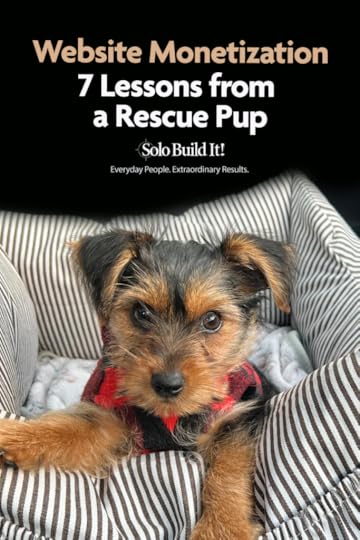 save pin for later
save pin for later  Follow the Rule of OneOne Thing: Focus on selling one primary solution per page.One Page: Dedicate a specific page (a sales page or review page) to that one solution.One Person: Write directly to your ideal customer avatar, as if you’re having a one-on-one conversation addressing their specific problem.One Problem: Ensure the page clearly addresses the single core problem this solution solves.One Solution: Present your recommended product/service as the solution to that specific problem on that page.
Follow the Rule of OneOne Thing: Focus on selling one primary solution per page.One Page: Dedicate a specific page (a sales page or review page) to that one solution.One Person: Write directly to your ideal customer avatar, as if you’re having a one-on-one conversation addressing their specific problem.One Problem: Ensure the page clearly addresses the single core problem this solution solves.One Solution: Present your recommended product/service as the solution to that specific problem on that page.Cath uses this effectively with separate, detailed review pages for her recommended rat trap and the automatic chicken feeder – two distinct solutions addressing the core “rat problem.”
Focus on Benefits, Not Just FeaturesThis is arguably the most crucial part of your product messaging.
People don’t buy features; they buy outcomes and transformations.
Feature: “This incubator has automatic temperature control.”
Benefit: “This incubator maintains the perfect temperature automatically, relieving the stress of constant monitoring and increasing your chances of a successful hatch.”
Always translate features into tangible benefits for the visitor. How does that feature make their life easier, solve their problem faster, reduce their anxiety, or help them achieve their desired outcome?
Keep Reviews AuthenticIf You Own/Use It: Share your personal experience, including photos or videos of you using the product. Talk about how it specifically helped you solve the problem. Mention drawbacks honestly, but frame them constructively (e.g., “It’s expensive, but it’s reliable and relieves stress,” or “It gets rusty, but it doesn’t affect performance”).
Create a unique rating system (like Cath’s Golden Eggs) to add personality and memorability.
If You Don’t Own/Use It: Be transparent! State clearly that you haven’t personally used it (like Cath’s Cackle Hatchery review). Explain why (e.g., “It’s only available in the US, and I live elsewhere”). Then, demonstrate you’ve done the homework for them by summarizing reviews from trusted sources (Amazon, Trustpilot, Google Business Profile, BBB, niche forums).
Highlight both pros and cons based on widespread user feedback. This still provides immense value and builds trust through honesty and thorough research.
Remove Distractions From Your Sales PagesKeep sales/review pages focused. Remove distractions like sidebars and unrelated ads (Cath turns off Mediavine ads on her sales pages). You want the visitor’s attention solely on the problem and the solution you’re presenting.
Use clear headings, short paragraphs, bullet points, and images/videos to make the information easy to digest.
 Don’t get your visitors all “tangled up” in confusing messaging and distractions.I is for Information Flow & Transformation: Walking in Their Shoes
Don’t get your visitors all “tangled up” in confusing messaging and distractions.I is for Information Flow & Transformation: Walking in Their ShoesThink of your sales page as a journey designed to guide your visitor from their current state (Point A: feeling frustrated, overwhelmed, in pain) to their desired future state (Point B: feeling relieved, confident, problem solved) because of your solution.
This is the “transformation” Pat Flynn talks about. Your job is to map out that journey clearly on the page.
Planning the TransformationCath uses a simple but powerful planning method:
Start (Top of Page): Define Point A. How is the visitor feeling before they encounter the solution? (e.g., “Stressed about rats,” “Anxious about incubation failure,” “Overwhelmed by wedding planning”). Use the emotive language you gathered earlier.End (Bottom of Page): Define Point B. How will the visitor feel after using the product? (e.g., “Will feel relieved and sleep better knowing rats are gone,” “Will feel confident about hatching healthy chicks,” “Will feel organised and excited about their wedding day”).Middle (The Bridge): Fill the gap with the product’s benefits. How does each benefit help move the visitor from Point A to Point B? Structure your page logically, addressing key questions, features (translated to benefits), drawbacks (with solutions/context), and proof (testimonials, your experience, reviews).Use pen and paper or post-it notes to physically map this out – it helps clarify the flow and ensures you stay visitor-focused.
It’s Not Always About PriceCath shared a relatable example involving her puppy. Which toy do you think became the absolute favorite? Not an expensive gadget from a pet store, but a simple, homemade toy crafted from an old sock and an inexpensive squeaky ball. It cost next to nothing but provided the most value to the puppy.
The website monetization lesson?
Don’t just promote the most expensive product because it offers a higher commission.
Recommend the product that genuinely best solves the visitor’s problem and provides the most appropriate value for them. Authenticity and genuine helpfulness lead to long-term trust and sales. Selling something unsuitable just for a higher commission ultimately damages that trust.
 Molly with her favorite toy: an old sock!N is for Nurturing & Next Steps (Beyond the Sale)
Molly with her favorite toy: an old sock!N is for Nurturing & Next Steps (Beyond the Sale)What happens if, after reading your brilliant sales page, the visitor doesn’t click “buy”? Don’t let them hit a dead end!
Offer Alternatives (At the Bottom): Once they’ve passed the final call to action, provide clear next steps. Cath includes links to related content at the very bottom of her sales pages (e.g., on the feeder page, she links to her main “Dealing with Rats” tier two page, her rat trap review, and other relevant feeding articles). Keep them engaged on your site, offering further value.The Power of Newsletters: This is Cath’s “ranty thing” for a reason. Your email list is one of your most valuable assets for building relationships and driving sales. People on your list already know you and have demonstrated trust by giving you their email address.Use it: Nurture your list with consistent value, but don’t be afraid to promote relevant products or link to your sales pages occasionally. (Amazon links are now allowed in emails).Build it: If you don’t have a newsletter, start one now, even if you only have a few pages up. It’s crucial for long-term monetization and relationship building. Many of Cath’s sales come directly from her trusted newsletter audience.Always offer value, whether through your content, your product recommendations, or your emails.
G is for Getting the Click (Call to Action – CTA)You’ve built trust, understood the problem, used their language, presented the solution and its benefits, and mapped the transformation. Now you need to ask for the click clearly and compellingly.
Be Clear & Specific: Don’t just say “Click Here.” Use action-oriented, benefit-focused language. Examples: “Download Your Free Starter Guide Now,” “Get Rid of Rats for Good – Buy Now,” “Start Your Stress-Free Incubation Today.”Benefit-Focused: Remind them of the positive outcome.Repeat Strategically: While you have one core call to action per page (buy the product, download the guide), repeat that offer multiple times using different formats (buttons, text links, clickable images) throughout the page (below the fold). People scan, and they might be ready to click at different points.Make Buttons Obvious: Use clear, contrasting buttons that stand out. Test different colours and wording.Remove Friction: By the time they reach your final CTA at the bottom, they should feel like clicking is the obvious, logical next step because you’ve addressed their problem, presented a compelling solution, and answered their potential objections.Website Monetization Strategies: Putting it All TogetherMonetizing your website successfully isn’t about complex tricks; it’s about applying the principles Cath Andrews learned from her rescue pup, Molly:
Build Trust First: Be authentic, helpful, and transparent. Your “About” page is key.Understand Your Audience Deeply: Know their pains, problems, and the language they use.Focus on Benefits: Sell the transformation, not just the features.Guide the Journey: Structure your sales pages logically from problem to solution.Be Genuine: Recommend what truly helps, not just what pays the most.Nurture Relationships: Use your newsletter to build trust and make relevant offers.Ask Clearly: Use compelling, benefit-focused calls to action.By “talking” to your audience in this way – understanding them, speaking their language, and focusing on solving their problems – you build the trust necessary for sustainable, ethical, and effective website monetization.
Now it’s your turn:
What are your biggest challenges with website monetization? Share your thoughts in the comments below!
Author information Carol Leather
Carol LeatherCarol Leather is head of content at SiteSell. She started her first successful online business, www.needlework-tips-and-techniques.com, with Solo Build It! in 2006 and it's still going strong. She loves photographing and drawing wildlife. She shares her walks in the English countryside on her new site www.naturewalkswithcarol.com. When she is not busy with all the above, she works on her two art sites! All using Solo Build It!, of course.
|The post The TALKING Method: A Dog Lover’s Guide to Website Monetization appeared first on SiteSell Blog - Proven Real-World Advice for Solopreneurs.
June 5, 2025
AI’s Real Impact on Your Website: Traffic, Trends & What To Do Now
In our previous exploration of “The Future of Search,” we established why chasing fleeting AI optimization “tricks” is a waste of time. The real key, as always, lies in creating outstanding, user-focused content.
But a crucial question remains: as AI Features like Google’s AI Overviews and standalone AI Products like ChatGPT become more prevalent, what will their actual impact be on your website’s traffic and income? Let’s dive deeper into these specifics.
The Rise of AI Features: Will Google’s AI Overviews Help or Hurt Your Site?We’ve previously discussed why AI Features (AIFs) like Google’s AI Overviews aren’t yet a primary traffic driver. But what happens when they are fully adopted?
One concern is clear: if AI Overviews perfectly satisfies a user’s search, they might not click through to your website, even if you previously received visitors for that query. This could directly impact your income.
It’s Not a Zero-Sum GameBut does this mean an inevitable drop in traffic? Not necessarily. The “zero-sum game” assumption – where total search volume remains static – might be flawed.
In reality, total search volume tends to increase. Consider two factors:
“AI Growth”: AI can introduce entirely new types of search queries (questions not typically asked of Google) and generate significant publicity, boosting overall search activity.
“Normal Growth”: Separately, Google’s own search volume has been growing by roughly 10% annually since 2020.
For discussion’s sake, let’s say “AI growth” adds 20% to search usage, and “normal growth” contributes its usual 10%. This totals 30% overall growth. In such a scenario, even if “regular search” lost 23% of its share within that expanded total, overall traffic (and therefore potential income) could remain stable compared to the previous year, perhaps even gaining some bonus clicks from AI Overviews.
Short vs. Long Keywords: Who Will “Switch” to AI Answers?Another way of looking at this…
What percentage of searchers are likely to “switch” from search to AIF? Short keyword terms are likely to remain as search. However, if you’re already planning to use 4, 5 or more words in your search, you’re already getting close to asking a question, so it’s a short hop to reading an AI Overview.
We need a few stats before we can estimate the AIF impact…
People use 1-, 2- and 3-word keywords for 21.7%, 24.0%, and 19.6% , respectively, of all searches (according to a Wordstream study). It’s reasonable to assume that these people will keep using regular search for straightforward keywords because the nature of the query is so different from a sentence or question in an AI prompt. Adding those values, it means that 65.3% of searches could remain unchanged.
The distribution drops off rapidly after that for long-tail keywords:
4-word keywords: 10-15%5-word keywords: 5-10%6-word keywords: 2-5%Backlinko found that the total of all long-tail keywords only amounts to 3.3% of the total search volume. Compared to the 22.5% average in the Wordstream study, that’s quite a difference.
Let’s take a conservative middle ground and estimate that long-tail keywords, ripe for becoming AI questions, account for roughly 13% of search.
The Current Picture: AI Overviews Adoption and “Low Impact” TheoryConsidering these factors, the immediate impact of AIFs like AI Overviews on your overall traffic volume might be less dramatic than feared. If a large portion of searches (short keywords) are less likely to shift, and only a smaller segment (long-tail) readily translates to AI questions, the overall traffic displacement could be moderate.
At the time of my research for “Make Your Site Win (Again),” AI Overviews appeared in just over 30% of search results, according to Advanced Web Ranking’s tracking tool.
While the AWR tool now indicates a figure closer to 50%, broader industry studies from early 2025 by sources such as Semrush and Conductor reported AI Overviews appearance rates for all U.S. desktop queries in the range of 13-14%.
Why these differences? It’s likely that the studies use different ways of measuring or look at different sets of keywords. What’s clear, though, is that even with these numbers changing and AI Overviews appearing more often, many searches still don’t show them.
When we combine this perspective with our earlier discussion about potential overall search growth, it stands to reason that the initial impact of AI Features on smaller sites may not be as severe as some predict.
However, let’s not ignore potential downsides.
What’s the Worst-Case Scenario?Google claims AI Overviews actually increases clicks to websites compared to traditional listings, stating:
“AI Overviews gets more clicks than if the page had appeared as a traditional web listing for that query.”
The SEO community remains skeptical, awaiting supporting data (Tick tock, tick tock…). While it’s good Google acknowledges the concern, let’s consider why AI Features (AIFs) might still lead to fewer clicks for your site:
Instant Gratification: If AI Overviews perfectly answers a user’s query, they may feel no need to click further, reducing visits to underlying websites.
Visual Dominance: AIFs often occupy significant screen space. This can push the traditional “10 blue links” further down, making them less visible and less likely to be clicked. (Though, as noted, the space AIFs take up has been adjusted over time.)
The Long Game for AI: As AIFs improve, they could theoretically satisfy so many queries directly that traditional search listings become less relevant over time.
While that last point is a more distant possibility, these are valid concerns. We’ll touch on the separate impact of standalone AI Products (AIPs) like ChatGPT or Gemini in the next section, but for now, their direct impact on your existing search traffic is minimal, potentially even offering bonus opportunities.
AI Product (Standalone Answer Engines): A Different Kind of Impact?Despite these potential downsides of AI Features like Google’s AI Overviews, I ultimately believe that small sites producing high-quality, winning content should fare well, perhaps even better, in the long run.
Now, let’s shift our focus to standalone AI Products (AIPs)—think dedicated platforms like ChatGPT, Gemini (at gemini.google.com), and Claude. Could their impact on your website actually be positive?
It’s an interesting question, especially when you consider their current accessibility. You won’t find direct links to gemini.google.com from the Google homepage or its search results, not even within an AI Overview.
To use these AIPs, people generally need to know they exist and navigate to them directly. This means they haven’t yet fully “crossed the chasm” into mainstream, everyday use for the average internet user.
So, for now, don’t worry about the standalone answer engines. In fact, they might even refer additional visitors to your site or blog.
How Could Standalone Answer Engines Be “Net Positive”?In time, we’ll learn to ask these standalone engines a ton of questions, seek explanations, etc. This is information that we need/want to know every day. Most people, however, have not trained themselves to ask them yet.
For example, I probably ask questions of ChatGPT, Gemini or Claude 15 to 20 times per day. It could be for something as simple as wanting to know which day of the year gets the most hurricanes. That said, I still need to remind myself… “hey, Self, ask Claude.”
Let me challenge you on this…How many times have you used one of the AI products to find out more about something that I wrote? I’ll bet there are still many of you who are answering, “None.”
Like I said, old habits are hard to change if the experience they deliver is still fine.
There are gazillions of questions for which we could be using these AI products, questions that don’t get a good response from search (e.g., asking for a step-by-step process for making marmalade, summarizing a document, explaining “crossing the chasm” with follow-up questions, etc.).
The Future Trajectory: AIP Adoption and Integration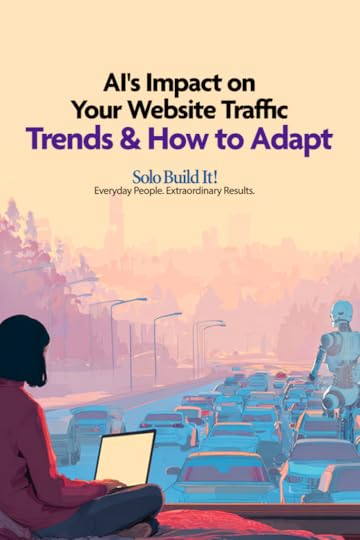 save pin for later
save pin for later 
When Google is finally satisfied with its testing, expect it to fully integrate its AI offerings —perhaps by making Gemini more prominent on its homepage or expanding AI Overviews usage.
Earlier, I estimated that perhaps only 15% of what we currently consider “regular searches” might eventually “switch” to being directly posed to standalone answer engines.
Given the simultaneous growth in overall search and the rise of new query types suited for AIPs, this potential shift in existing habits is unlikely to feel like a significant drop. Instead, as more people discover the unique benefits of direct AIP interaction for complex tasks or exploratory questions, these platforms represent a growing source of bonus traffic potential.
So, expect standalone answer engines to become steadily more popular. This adoption might take longer than expected, but it’s a clear trend. Better results drive more usage, and more usage (and user feedback) drives better results—a classic positive feedback loop.
Beyond search itself, this technology will be integrated into all kinds of other products (e.g., your smartphone’s AI personal assistant). Some will have a results page with links (e.g., personal assistant queries), others may not.
In time, I do expect LLMs to pay the sources of their content (i.e., you!), including large, aggregated groups of smaller sites. As these standalone answer engines become widely, even wildly, popular, the mechanisms for this “payback” could mean more income for you, the content creator.
It’s a “Field of Dreams” scenario: if you build excellent, helpful content, the audience (and the opportunities) will come.
SearchGPT: A Glimmer of Hope for Content Creators?OpenAI’s SearchGPT is a prototype search engine, designed to leverage the power of AI for enhanced search capabilities.
This search engine combines the strengths of OpenAI’s GPT-4 models with real-time information from the web, aiming to provide users with fast and accurate answers accompanied by clear and relevant source links.
Why SearchGPT Is Intriguing for Searchers, And Even Better for MarketersThis prototype is particularly noteworthy because it aims to respect and support publishers by prominently citing sources and offering ways for them to manage how their content appears in the search results.
This gives what I foresee as an opportunity to an entrepreneur who aggregates and represents millions of smaller sites. If AI Overviews and Copilot had not yet recognized the wisdom of paying high-quality sites, it could cause sites to insert a bit of code onto every web page, telling Google’s and Microsoft’s AI to stay away, putting them at a huge data disadvantage.
A rapid, viral spread by such a standalone answer engine could be a favorable development with mid- and long-term financial benefits, all while the short-term impact is negligible.
An In-Depth Look at SearchGPTIt’s a beta release that went into testing with 10,000 users at launch.
What’s the difference between this and regular search? It delivers a summary of web pages that rank highest for a keyword search, rather than just presenting 10BLs.
You can ask follow-up questions.
It prominently cites its sources, with clear, inline links that lets visitors know where the info came from. Visitors can click to read more from sources.
It provides even more results in a sidebar with source links.
Is SearchGPT in Direct Competition to Perplexity?Both SearchGPT and Perplexity function similarly. Unlike Perplexity though, which has had legal problems with publishers, OpenAI’s SearchGPT was developed in collaboration with various news partners (e.g., Wall Street Journal, Associated Press, etc.).
Publishers can manage how they appear in search features. They can even opt out of their content being used and still be surfaced in search.
What has OpenAI not told us? How it plans to monetize!
It’s spending billions of dollars to develop SearchGPT. It has massive ongoing expenses for compute time, electricity (a massive expense), ongoing hardware requirements, bandwidth, etc.
It needs to figure out monetization quickly. It’s fair to say that content websites are unlikely to be paid until AI-based search products figure out how to pay themselves. And that’s OK because we’d only be “losing” income that did not exist yet! Once the ads start scaling, though, I’d expect high-ranking sites to generate income with SearchGPT.
How SearchGPT Could Reshape Creator CompensationLet’s restate this, as it’s a crucial point: SearchGPT, if its publisher-friendly model becomes influential, offers strong positives for content creators.
By emphasizing source citation and providing additional links, it presents a model where income lost from shifts in “regular” search could potentially be offset, or even exceeded, especially if competitive pressure encourages other AI platforms to adopt similar practices.
A Fundamental Difference: SearchGPT vs. Traditional LLM BehaviorIt’s also important to understand a key difference here. Traditional Large Language Models (LLMs) like Gemini, ChatGPT, and Claude synthesize answers from their vast internal knowledge base (much the same way that we all do). The LLM has no idea where the info came from.
SearchGPT, on the other hand, acts more like an enhanced search engine. It “reads” relevant web pages in response to a query, then organizes and summarizes that content for easy consumption. This inherent connection to source material is why it’s providing more citations.
The Path to “Enlightenment”: Why AI Engines Need to Value Small CreatorsBecause SearchGPT works differently and could create competition, other AI tools might also start to better recognize and reward smaller sites for their quality content.
The bottom line is this: while a decrease in “regular” Google search traffic initially impacts income for niche websites, this pressure could be counteracted if…
Publisher-centric models like SearchGPT gain traction and influence other Standalone Answer Engines, orThe major AI players reach a state of “enlightenment.”What do I mean by “enlightened?” It’s the realization that the long-term health and richness of the web—and therefore their own AI products which rely on that web content—depends on the survival and thriving of millions of smaller, independent content creators.
Between this potential for competitive pressure and the fundamental need to treat smaller sites as partners (much like they already do with major publishers), I believe the mid- to long-term future for small sites producing quality content is excellent.
So, What’s the Real Deal with AI and Your Site? (And What To Do Now )We’ve looked at AI Features like Google’s AI Overviews and standalone AI Products like ChatGPT, Gemini and Claude. The truth is, while they’re definitely changing things, their direct impact on your traffic right now might not be as significant as some folks make it out to be.
Overall search is growing, and many people aren’t using these AI tools for every little thing just yet.
Plus, the good news is that these AI tools are getting better at giving credit (that means links!) where it’s due. That’s a win for those of us creating great, original stuff.
If your traffic has taken a nosedive lately, chances are it’s less about AI Overviews stealing your clicks and much more about Google’s regular algorithm updates, like the Helpful Content Update (HCU). That’s what’s shaking things up for most websites right now.
So, while it’s smart to keep an eye on how AI is changing search for the long haul, your immediate focus needs to be on fixing what’s likely hurting you today.
And that’s exactly what Part 2 of my book, “Make Your Site Win (Again),” is all about. It’s a step-by-step Traffic Recovery Program. No fluff, no chasing AI fads. Just a solid plan to get your content back in shape, making it the kind of stuff users love and Google wants to rank.
The full “Traffic Recovery Program” is waiting for you inside Solo Build It! (SBI!). It’s all part of the deal—the book, the tools, the know-how, the community—everything you need to get your site winning again, no matter what Google or AI throws your way.
Get SBI! for WP Now (Intro Price) Get SBI! Now (Intro Price)
Stay on top of AI developments and how they impact you as a blogger or online business owner. Subscribe to our free newsletter, and never miss a new article.
Subscribe For FreeEmail Address By subscribing, I consent to receiving emails from Solo Build It!(function($) {window.fnames = new Array(); window.ftypes = new Array();fnames[0]='EMAIL';ftypes[0]='email';fnames[1]='FNAME';ftypes[1]='text';fnames[2]='LNAME';ftypes[2]='text';}(jQuery));var $mcj = jQuery.noConflict(true);
Read Other Articles in This Series:
Ken Evoy Releases New Book to Help Website Owners Recover from Google Updates
Beyond the Helpful Content Update: The Real Lessons Google is Teaching Us About the Future of Search
Large Language Models: What Content Creators Need to Know
Understanding the 3 Phases of Search: A Guide for Website Owners
The Future of Search: Why Obsessing Over AI Optimization Misses the Point
Author information
 Ken Evoy (CEO, SiteSell)
Ken Evoy (CEO, SiteSell)Ken Evoy is the Founder, CEO, and Chairman of the Board of SiteSell Inc. He is the creator of Solo Build It!, SiteSell's comprehensive online business-building system and Tai, SBI!’s business building AI-assistant. Ken is also a successful inventor, author, and emergency physician. He feels strongly that solopreneurs can be empowered by leveraging their income-building potential online.
|The post AI’s Real Impact on Your Website: Traffic, Trends & What To Do Now appeared first on SiteSell Blog - Proven Real-World Advice for Solopreneurs.
May 15, 2025
The Future of Search: Why Obsessing Over AI Optimization Misses the Point
In article number three in this series, we looked at how search has changed over time — from the early days of web directories all the way to the AI features we’re starting to see now. Through all those changes, your main goal as a website owner has always been the same: to write for and connect with your audience.
Now, as search technology gets more complex, ranking high at search engines paradoxically becomes simpler. That’s “simpler,” not “easier.”
To do well, you really need to get a handle on where AI is headed, especially understanding Google’s big role in all this and what things like AI Overviews will actually mean for your website. So, let’s explore what this future of search looks like.
Why Google Will Be at the Top of the AI RaceI expect Google to continue optimizing its AI search quality and how it presents AI Feature results. Expect Google to be the thought leader. Why do I think Google will push forward faster? Two reasons…
Google’s High Stakes: Why They Must Win at AIGoogle’s market cap is $2.16 trillion dollars, the fifth largest in the world. Approximately 60% of its gross income comes from its core search business. This is financial risk at an order of magnitude greater than any other company.
Google’s AI Advantage: Talent, Tech & TimeGoogle has been the leader in AI since acquiring DeepMind in 2014. DeepMind had started in 2010, so that gave Google a head start, and a world-class AI team. Google Brain, started at Google in 2011 as a “20% time” project, ramped up and was soon doing cutting edge research.
By 2017, it was widely regarded as the most advanced AI group in the world. In 2017, it published a paper called “Attention Is All You Need.” This introduced the concept of Transformer architecture, which went on to become the foundation of all generative AI (GAI).
OpenAI was founded in 2015 by Sam Altman, Elon Musk and others, when they realized that this was the future. They recognized the importance of the Transformer concept. By 2018, they published a report about what a Generative Pre-trained Transformer (GPT) is.
And the race was on!
OpenAI released GPT-3 to the public in November 2022. Its worldwide success took everyone by surprise because GPT-2 had been used mostly by researchers and AI enthusiasts.
Google was caught flat-footed. By the time it launched Bard (Gemini’s predecessor) four months later, ChatGPT had a lead of hundreds of thousands of users.
Google plodded along after its launch of Bard. Its extreme cautiousness (fear of making mistakes) and rigid practices slowed it down.
Since then, though, it has adapted to OpenAI’s pace. OpenAI remains ahead, but you can almost feel Google’s momentum machine steadily catching up.
Let’s fast-forward from that momentous event of 2022 to April 2023, when Google Brain merged with DeepMind, forming “Google Deepmind.” The goal was to create increased efficiency and to accelerate AI research and development.
Bringing the two teams together carried other synergies, as well. They formed the strongest team of brilliant AI researchers in the world.
No other company has the historical strength nor the depth of world class AI engineers. Google’s AI efforts deserve deep respect, even if OpenAI has garnered most of the publicity.
The only way that Google loses this race to OpenAI will be because of OpenAI’s superior marketing. Wait, let me say that in a different way… because of Google’s terrible marketing.
Google’s Present and Future with AI The Drive for Dominance: Google’s AI MotivationNot only does Google have the resources to get this right, it has a financial motivation to maintain or grow its share of AI search functionality.
That’s why Google is experimenting so aggressively on AI Overview. The goal is to maintain, or even grow, its 90+% market share of search. Like Microsoft, Google is integrating its AI into Gmail, Google Docs, Google Sheets, etc.
For Google, the huge prize is to hold search share. Similarly, Microsoft will valiantly defend its Office software suite through AI integration, where it holds the commanding share.
How Strong is Google’s Distribution Power?These figures say it all…
AI Overview initially (in beta or as Search Generative Experience) displayed in 80% of all Google searches. That figure has dropped from those mid-April 2024 numbers to around 27%, and is currently (May 2025) back up at around 40%. You can check the numbers for yourself at this free AI Overview tool.
That’s why you may see AI Overview for a given search, while someone else doesn’t, or while it appears for one search, but not for another. Google simply doesn’t need more than that to test scores of ideas at a time.
Meanwhile, by keeping distribution “limited” (by Google’s standards), it prevents an embarrassing mistake from spreading around the globe.
The numerous fiascos of terrible, embarrassing replies by Gemini (and the others)…are way over-exaggerated. Consider the numerator (reported bad answers) and divide by the denominator (completed prompts). If the answer is more than 0.01%, I’d be stunned.have often been manipulations by those with agendas. Yes, it’s still possible to generate embarrassing answers by leading that innocent little GAI down the garden path of heavy context, until the person finally gets crazy responses.These “meme-ers” don’t say how they did it in a way that others can reproduce. That would expose the truth. Suffice it to say that there’s no way you would ever accidentally wander down these carefully manipulated garden paths.
So, depending upon how much exposure Google gives AI Overview, you may or may not notice traffic changes from it. Regardless, until Google is satisfied that AI Overview is working well, don’t expect much consistent traffic from AI Overview.
What Are SEOers Doing?Why Obsessing Over AI Changes Misses the PointMany SEO experts spend huge amounts of time tracking and reporting on those changes. If ever there was a “forest for the trees” example, it’s modern-day SEO voodoo.
Most of it is of little import to site owners because…
You won’t change your content to chase after this stuff.The LLMs (Large Language Models) will master recognizing content quality in the not-too-distant future.Even now, it doesn’t matter for site owners because1) AI Overview is not used by many people, and2) Google is still testing AI Overview.A Look at Google’s AI Overview Testing Strategy
Here are some examples of how Google optimizes results through experimentation…
Test more concise presentations on a smaller on-page size (i.e., reducing vertical real estate).Use it for certain types of questions, not for others.Change SERP and/or AI Overview configuration for other page element placement, especially to make room for ads (i.e., within the AI essay itself). The idea, of course, is to optimize ad income.Reduce the risks of publicly visible incorrect answers.Optimize for specific industries. Every industry has its own dynamics and lingo. This is an important part of maximizing ad income.Experiment with totally new formats. I can’t imagine what this might look like, nor would there be any point to doing it, even if I could. But I wouldn’t dismiss the possibility of Google developing a radical new way to increase ads, decrease pushback against the ads, increase click-through, and increase the advertisers’ ROI. WIN-WIN-WIN.What Fluctuating AI Traffic Really Means (Hint: Not Much, Yet)Here’s the most relevant point for you regarding all this experimentation…
You may not see much, if any, traffic from it. If you do, you’ll see fluctuations in traffic. This will happen until Google has determined its best user-satisfying and income-earning placements in its SERPs.
A traffic gain or loss from AI Overview does not mean that Google is upgrading or downgrading your site’s content. It means it’s experimenting for the short-to-medium term.
Forget AI Tracking, Instead Focus on the Core Strategy That Still WinsIn the longer term, I just can’t see Google continuing to make it so hard to use AI Overview once it’s confident in how well these overviews are working. Also, expect AI Overview’s format to change over time, perhaps closer to that of Microsoft (Bing), or to a radically different format.
 save pin for later
save pin for later 
For now, it’s unlikely that any significant Google traffic loss comes from AIFs. They just aren’t seen by enough people yet. That will change, but none of it matters for you because your best strategy is still to make your content as good as humanly (that’s you!) possible.
These are early days in our transition to AI in every industry, including search. Forget about this being “the first inning” of the metaphorical baseball game. However, continuing with that metaphor…
The first batter of the top of the first inning has only seen two pitches!
Like any transformational new technology, from fire to electricity to the web, usage and formats will change greatly. The first-generation implementations are immediately obvious. It’s the next ones that accelerate everything. Translating that to today…
Consider the wide variety of how the major LLMs (e.g., ChatGPT, Gemini, Claude, Perplexity) present their ad-free organic results. They still need to figure out the best-paying ways to blend in their advertising, each varying according to the organic presentation. It will likely be 6 to 12 months before this all settles down. In short…
“You ain’t seen nothin’ yet.”
Given the volatility of changes of all kinds and that some features, such as Google’s AI Overview, are not sending much traffic, it would be a waste of time to make changes specifically for a single feature.
The bottom line for right now, and forever (which I suspect will be more and more valid) is: Simply stick with what you’ve been doing already. Create the most informative, high-value content that OVERdelivers on search intent.
What stands you in good stead for regular search, should also work well for AI features.
This is all the more true as we’re seeing a trend towards better source citation across all major AI tools, including Google’s AI Overview and Gemini. Driven by user demand for verification and the need to reward creators, this ‘payback’ via links is improving. And that improvement further validates the long-term strategy of creating outstanding content.
So even though “You ain’t seen nothin’ yet”…
You don’t need to worry, track or react to AI Features, like AI Overview, for now.
How Can AI Features Generate Traffic for You?Google’s AI Overview and Microsoft’s CoPilot both use their underlying generative AI technologies (Gemini and ChatGPT, respectively) to generate answers, synthesizing all that they “know” into summarizing essays, with the 10 blue links below the essay.
These are the 10 highest quality and most relevant web pages on the topic, as determined by the ranking algo of each engine.
Generative AI delivers answers on the fly, i.e., it doesn’t save its answers. That’s why answers will change somewhat from query to query. For example, if I were to write content for a web page about “Cheap Anguilla villas,” and then do it again the next day, the two essays would be similar, but not identical.
On the other hand, regular search’s 10BLs won’t vary until the next algo release. Google, and every other search engine, delivers the same “top 10” for the same query, every time (until the next algo update).
What’s the smart traffic-building takeaway from these simple facts? It makes little sense to develop specifically for AIFs. They change too quickly, and, in any event, the SBI!/Tai process for creating content covers you well.
SEO vs. AIO — What’s the Difference?The Myth of AIO: Can You Really “Optimize” for AI Overview Links?“AIO” stands for “AI Optimization,” and could also be used for “AI Overview.” We’ll generally use it to mean “AI Optimization.” I prefer to write out “AI Overview,” just to avoid any confusion (on my part, not yours).
So… what’s the difference between SEO and AIO?
I’ve already seen SEOers promote AIO tactics for how to be chosen as one of the links provided by Gemini in AI Overview. That’s incredible…
Aren’t they aware that the entire human knowledge-base of everything since the beginning of time has been sucked into the “data vacuums” called Gemini and ChatGPT, etc.? And that it’s not an algorithm that drives this AI search?
Do they realize how rapidly AI is going to improve in the coming months? The ability to manipulate SERPs using SEO is already at an all-time low — it’s going to zero for both AI Overview and standalone AIP (Gemini, ChatGPT and Claude). All in all, it’s fair to say that…
Beating AI search by specific AI optimization techniques is impossible.
The Power (and Unpredictability) of AI Search EnginesAI Overview provides more accurate and relevant answers, and it can go deeper in any direction you choose. It works well for both simple and complex queries.
Smartphones will actually be “smart”! Imagine asking your iPhone or Android whatever question pops into your mind. This could change my prediction regarding how long AI as a smart search engine could take to substantially impact Google’s 10BL search product.
It will continuously learn and improve from user interactions (learning you, basically), enhancing the accuracy and relevance of the answers for you over time.
Not all searches will trigger an AI Overview response. For example, Google claims AI Overview will be used to answer more complex questions where it can add value beyond traditional search results. If it figures that the old-fashioned 10BL format will do a better job, it’ll stick with that.
The Bottom Line: Focus on Quality Content, Not AIOIn general, AI Overview and Gemini impact informational content more than transactional content. And you can’t beat it with AIO. Finally, AI Overview cites top-ranking sites that contribute to the search answer. The bottom line is simple…
Don’t waste your time on AIO as a separate strategy to learn. If you generate high rankings at regular search, you’ll receive your fair share of citations in AI Overviews.
Stay on top of AI developments and how they impact you as a blogger or online business owner. Subscribe to our free newsletter, and never miss a new article.
Subscribe For FreeEmail Address By subscribing, I consent to receiving emails from Solo Build It!(function($) {window.fnames = new Array(); window.ftypes = new Array();fnames[0]='EMAIL';ftypes[0]='email';fnames[1]='FNAME';ftypes[1]='text';fnames[2]='LNAME';ftypes[2]='text';}(jQuery));var $mcj = jQuery.noConflict(true);
Read Other Articles in This Series:
Ken Evoy Releases New Book to Help Website Owners Recover from Google Updates
Beyond the Helpful Content Update: The Real Lessons Google is Teaching Us About the Future of Search
Large Language Models: What Content Creators Need to Know
Understanding the 3 Phases of Search: A Guide for Website Owners
Author information Ken Evoy (CEO, SiteSell)
Ken Evoy (CEO, SiteSell)Ken Evoy is the Founder, CEO, and Chairman of the Board of SiteSell Inc. He is the creator of Solo Build It!, SiteSell's comprehensive online business-building system and Tai, SBI!’s business building AI-assistant. Ken is also a successful inventor, author, and emergency physician. He feels strongly that solopreneurs can be empowered by leveraging their income-building potential online.
|The post The Future of Search: Why Obsessing Over AI Optimization Misses the Point appeared first on SiteSell Blog - Proven Real-World Advice for Solopreneurs.

